Rio de Janeiro
| Rio de Janeiro | |||
|---|---|---|---|
| Municipality | |||
| Município do Rio de Janeiro Municipality of Rio de Janeiro | |||
|
From the top, left to right: Christ the Redeemer, Botafogo's cove, Rio Downtown, Rio–Niterói bridge, Maracanã Stadium, and panoramic view of Barra da Tijuca from Pedra da Gávea | |||
| |||
| Nickname(s): Cidade Maravilhosa (Marvelous City) Princesa Maravilhosa (Marvelous Princess) Cidade dos Brasileiros (City of Brazilians) | |||
 Location in the state of Rio de Janeiro | |||
 Rio de Janeiro Location in Brazil | |||
| Coordinates: 22°54′30″S 43°11′47″W / 22.90833°S 43.19639°WCoordinates: 22°54′30″S 43°11′47″W / 22.90833°S 43.19639°W | |||
| Country |
| ||
| Region | Southeast | ||
| State |
| ||
| Founded | 1 March 1565[1] | ||
| Government | |||
| • Mayor | Eduardo Paes (PMDB) | ||
| Area | |||
| • Municipality | 1,221 km2 (486.5 sq mi) | ||
| • Metro | 4,539.8 km2 (1,759.6 sq mi) | ||
| Elevation | from 0 to 1,020 m (from 0 to 3,349 ft) | ||
| Population (2015)[2] | |||
| • Municipality | 6,453,682 | ||
| • Rank | 2nd | ||
| • Urban | 11,616,000 | ||
| • Metro | 12,280,702 (2nd) | ||
| • Metro density | 2,705.1/km2 (7,006/sq mi) | ||
| Demonym(s) | Carioca and Guanabarino(a) (by former city-state, obsolete) | ||
| Time zone | BRT (UTC−3) | ||
| • Summer (DST) | BRST (UTC−2) | ||
| Postal Code | 20000-000 | ||
| Area code(s) | +55 21 | ||
| Website | Rio de Janeiro, RJ | ||
| Type | Cultural | ||
| Criteria | vi | ||
| Designated | 2012 (36th session) | ||
| Reference no. | 1100 | ||
| State Party | Brazil | ||
| Latin America and Europe | |||
Rio de Janeiro (/ˈriːoʊ di ʒəˈnɛəroʊ, -deɪ ʒə-, -də dʒə-/; Portuguese pronunciation: [ˈʁi.u d(ʒi) ʒɐˈnejɾu];[3] River of January), or simply Rio,[4] is the second-most populous municipality in Brazil and the sixth-most populous in the Americas. The metropolis is anchor to the Rio de Janeiro metropolitan area, the second-most populous metropolitan area in Brazil and sixth-most populous in the Americas. Rio de Janeiro is the capital of the state of Rio de Janeiro, Brazil's third-most populous state. Part of the city has been designated as a World Heritage Site, named "Rio de Janeiro: Carioca Landscapes between the Mountain and the Sea", by UNESCO on 1 July 2012 as a Cultural Landscape.[5]
Founded in 1565 by the Portuguese, the city was initially the seat of the Captaincy of Rio de Janeiro, a domain of the Portuguese Empire. Later, in 1763, it became the capital of the State of Brazil, a state of the Portuguese Empire. In 1808, when the Portuguese Royal Court transferred itself from Portugal to Brazil, Rio de Janeiro became the chosen seat of the court of Queen Maria I of Portugal, who subsequently, in 1815, under the leadership of her son, the Prince Regent, and future King João VI of Portugal, raised Brazil to the dignity of a kingdom, within the United Kingdom of Portugal, Brazil, and Algarves. Rio stayed the capital of the pluricontinental Lusitanian monarchy until 1822, when the War of Brazilian Independence began. This is one of the few instances in history that the capital of a colonising country officially shifted to a city in one of its colonies. Rio de Janeiro subsequently served as the capital of the independent monarchy, the Empire of Brazil, until 1889, and then the capital of a republican Brazil until 1960 when the capital was transferred to Brasília.
Rio de Janeiro has the second largest municipal GDP in the country,[6] and 30th largest in the world in 2008,[7] estimated at about R$343 billion (IBGE, 2008) (nearly US$201 billion). It is headquarters to Brazilian oil, mining, and telecommunications companies, including two of the country's major corporations—Petrobras and Vale—and Latin America's largest telemedia conglomerate, Grupo Globo. The home of many universities and institutes, it is the second-largest center of research and development in Brazil, accounting for 17% of national scientific output according to 2005 data.[8]
Rio de Janeiro is one of the most visited cities in the Southern Hemisphere and is known for its natural settings, Carnival, samba, bossa nova, and balneario beaches[9] such as Barra da Tijuca, Copacabana, Ipanema, and Leblon. In addition to the beaches, some of the most famous landmarks include the giant statue of Christ the Redeemer atop Corcovado mountain, named one of the New Seven Wonders of the World; Sugarloaf Mountain with its cable car; the Sambódromo (Sambadrome), a permanent grandstand-lined parade avenue which is used during Carnival; and Maracanã Stadium, one of the world's largest football stadiums.
Rio de Janeiro was the host of the 2016 Summer Olympics and the 2016 Summer Paralympics, making the city the first South American and Portuguese-speaking city to host the events, and the third time the Olympics were held in a Southern Hemisphere city.[10] The Maracanã Stadium held the finals of the 1950 and 2014 FIFA World Cups, the 2013 FIFA Confederations Cup, and the XV Pan American Games.
History
![]() Portuguese Empire 1565–1815
Portuguese Empire 1565–1815
![]() United Kingdom of Portugal, Brazil and the Algarves 1815–1822
United Kingdom of Portugal, Brazil and the Algarves 1815–1822
![]() Empire of Brazil 1822–1889
Empire of Brazil 1822–1889![]() Republic of Brazil 1889–present
Republic of Brazil 1889–present
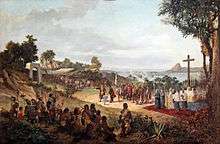


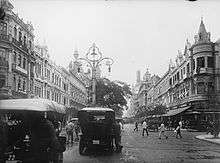
Europeans first encountered Guanabara Bay on 1 January 1502 (hence Rio de Janeiro, "January River"), by a Portuguese expedition under explorer Gaspar de Lemos captain of a ship in Pedro Álvares Cabral's fleet, or under Gonçalo Coelho.[11] Allegedly the Florentine explorer Amerigo Vespucci participated as observer at the invitation of King Manuel I in the same expedition. The region of Rio was inhabited by the Tupi, Puri, Botocudo and Maxakalí peoples.[12]
In 1555, one of the islands of Guanabara Bay, now called Villegagnon Island, was occupied by 500 French colonists under the French admiral Nicolas Durand de Villegaignon. Consequently, Villegagnon built Fort Coligny on the island when attempting to establish the France Antarctique colony.
The city of Rio de Janeiro proper was founded by the Portuguese on 1 March 1565 and was named São Sebastião do Rio de Janeiro, in honour of St. Sebastian, the saint who was the namesake and patron of the then Portuguese Monarch D. Sebastião. Rio de Janeiro was the name of Guanabara Bay. Until early in the 18th century, the city was threatened or invaded by several, mostly French, pirates and buccaneers, such as Jean-François Duclerc and René Duguay-Trouin.[13]
In the late 17th century, still during the Sugar Era, the Bandeirantes found gold and diamonds in the neighbouring captaincy of Minas Gerais, thus Rio de Janeiro became a much more practical port for exporting wealth (gold, precious stones, besides the sugar) than Salvador, Bahia, which is much farther to the northeast. On 27 January 1763,[14] the colonial administration in Portuguese America was moved from Salvador to Rio de Janeiro. The city remained primarily a colonial capital until 1808, when the Portuguese royal family and most of the associated Lisbon nobles, fleeing from Napoleon's invasion of Portugal, moved to Rio de Janeiro. The kingdom's capital was transferred to the city, which, thus, became the only European capital outside of Europe. As there was no physical space or urban structure to accommodate hundreds of noblemen who arrived suddenly, many inhabitants were simply evicted from their homes.[15] There was a large influx of African slaves to Rio de Janeiro: in 1819, there were 145,000 slaves in the captaincy. In 1840, the number of slaves reached 220,000 people.[16]
When Prince Pedro proclaimed the independence of Brazil in 1822, he decided to keep Rio de Janeiro as the capital of his new empire. Rio continued as the capital of Brazil after 1889, when the monarchy was replaced by a republic. Until the early years of the 20th century, the city was largely limited to the neighbourhood now known as the historic city centre (see below), on the mouth of Guanabara Bay. The city's centre of gravity began to shift south and west to the so-called Zona Sul (South Zone) in the early part of the 20th century, when the first tunnel was built under the mountains between Botafogo and the neighbourhood that is now known as Copacabana. Expansion of the city to the north and south was facilitated by the consolidation and electrification of Rio's streetcar transit system after 1905.[17] Botafogo's natural beauty, combined with the fame of the Copacabana Palace Hotel, the luxury hotel of the Americas in the 1930s, helped Rio to gain the reputation it still holds today as a beach party town (although this reputation has been somewhat tarnished in recent years by favela violence resulting from the narcotics trade[18]). Plans for moving the nation's capital city to the territorial centre had been occasionally discussed, and when Juscelino Kubitschek was elected president in 1955, it was partially on the strength of promises to build a new capital.[19] Though many thought that it was just campaign rhetoric, Kubitschek managed to have Brasília built, at great cost, by 1960. On 21 April that year the capital of Brazil was officially moved from Rio de Janeiro to Brasília.
Between 1960 and 1975, Rio was a city-state under the name Guanabara State (after the bay it borders). However, for administrative and political reasons, a presidential decree known as "The Fusion" removed the city's federative status and merged it with the State of Rio de Janeiro, the territory surrounding the city whose capital was Niterói, in 1975.
The city hosted the 2007 Pan American Games and the 2014 FIFA World Cup Final. On 2 October 2009, the International Olympic Committee announced that Rio de Janeiro would host the 2016 Olympic Games and the 2016 Paralympic Games, beating the finalist competitors Chicago, Tokyo, and Madrid. The city became the first South American city to host the event and the second Latin American city (after Mexico City in 1968) to host the Games. The city hosted the World Youth Day in 2013, the second World Youth Day in South America and first in Brazil.
Geography

Rio de Janeiro is on the far western part of a strip of Brazil's Atlantic coast (between a strait east to Ilha Grande, on the Costa Verde, and the Cabo Frio), close to the Tropic of Capricorn, where the shoreline is oriented east–west. Facing largely south, the city was founded on an inlet of this stretch of the coast, Guanabara Bay (Baía de Guanabara), and its entrance is marked by a point of land called Sugar Loaf (Pão de Açúcar)—a "calling card" of the city.[20]
The Centre (Centro), the core of Rio, lies on the plains of the western shore of Guanabara Bay. The greater portion of the city, commonly referred to as the North Zone (Zona Norte), extends to the northwest on plains composed of marine and continental sediments and on hills and several rocky mountains. The South Zone (Zona Sul) of the city, reaching the beaches fringing the open sea, is cut off from the Centre and from the North Zone by coastal mountains. These mountains and hills are offshoots of the Serra do Mar to the northwest, the ancient gneiss-granite mountain chain that forms the southern slopes of the Brazilian Highlands. The large West Zone (Zona Oeste), long cut off by the mountainous terrain, had been made more easily accessible by those on the South Zone by new roads and tunnels by the end of the 20th century.[21]
The population of the city of Rio de Janeiro, occupying an area of 1,182.3 square kilometres (456.5 sq mi),[22] is about 6,000,000.[23] The population of the greater metropolitan area is estimated at 11–13.5 million. It was Brazil's capital until 1960, when Brasília took its place. Residents of the city are known as cariocas. The official song of Rio is "Cidade Maravilhosa", by composer André Filho.

Climate
Rio has a tropical savanna climate (Aw) that closely borders a tropical monsoon climate (Am) according to the Köppen climate classification, and is often characterized by long periods of heavy rain from December to March.[24] In inland areas of the city, temperatures above 40 °C (104 °F) are common during the summer, though rarely for long periods, while maximum temperatures above 27 °C (81 °F) can occur on a monthly basis.
Along the coast, the breeze, blowing onshore and offshore, moderates the temperature. Because of its geographic situation, the city is often reached, especially during autumn and winter, by cold fronts advancing from Antarctica, causing frequent weather changes. It is mostly in summer that strong showers provoke catastrophic floods and landslides. The mountainous areas register greater rainfall since they constitute a barrier to the humid wind that comes from the Atlantic.[25]


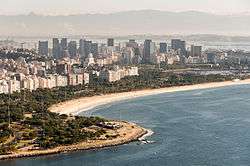
The city reputedly has had rare frosts in the past, but this has never been decisively confirmed. Some areas within Rio de Janeiro state occasionally have falls of snow grains and ice pellets (popularly called granizo, or "hail", although it is in fact melted and refrozen snow falling in the form of a ball—true hail, rather than just icy snow along showers, is much less common). These phenomena are definitely not rare or limited to a few regions, having already happened in the metropolitan area (including western suburbs of the city itself) several times in the 21st century.[26][27][28] In other areas there is true snowfall more than once in each century (the last time this occurred in Rio de Janeiro state was in the mid-1980s), most commonly around the highest mountain in the state (for perhaps centuries thought to be the country's highest) and fifth highest in the country, Pico das Agulhas Negras, in the cities of Resende and Itatiaia (in lower latitudes than Rio de Janeiro, but much higher altitudes).
Elsewhere in the state, drought is very rare, albeit bound to happen occasionally given its strongly seasonal tropical climate. The Brazilian drought of 2014–2015, most severe in the Southeast Region and the worst in decades, affected the entire metropolitan region's water supply (a diversion from the Paraíba do Sul River to the Guandu River is a major source for the state's most populous mesoregion). Plans to divert the Paraíba do Sul to the Sistema Cantareira (Cantareira system) during its water crisis of 2014, in order to help the critically drought-stricken Greater São Paulo area, offered the easiest short-term response to the consequences of climate change and the deforestation of the Amazon rainforest (itself affecting climate change), an issue expected to linger across the entire country in the near future. This will likely make the situation even more complex, however, as sufficient rainfall to supply tap water service to both metropolitan areas in the future is merely speculative.[29][30][31] This circumstance, as shown in a recent central government report, is worsened by the fact that 37% of the country's tap water is being lost because of leaky pipes (sometimes resulting in contaminated water), fraud and illegal access,[32] and by the country's use of hydroelectric power as its main energy source.
Roughly in the same suburbs (Nova Iguaçu and surrounding areas, including parts of Campo Grande and Bangu) that correspond to the location of the March 2012, February–March 2013 and January 2015 pseudo-hail (granizo) falls, there was a tornado-like phenomenon in January 2011, for the first time in the region's recorded history, causing structural damage and long-lasting blackouts, but no fatalities.[33][34] The World Meteorological Organization has advised that Brazil, especially its southeastern region, must be prepared for increasingly severe weather occurrences in the near future, since events such as the catastrophic January 2011 Rio de Janeiro floods and mudslides are not an isolated phenomenon. "This (the early 2010s serial devastation in Rio de Janeiro's mesoregions of Metropolitana do Rio de Janeiro and Sul Fluminense) was not an isolated event. The events in Brazil confirms a global trend that storms tend to be increasingly strong and in places where it did not take place with the same force", said Rupakumar Kolli, WMO expert on climatological phenomena.[34] In early May 2013, winds registering above 90 km/h (56 mph) caused blackouts in 15 neighborhoods of the city and three surrounding municipalities, and killed one person.[35] Rio saw similarly high winds (about 100 km/h (62 mph)) in January 2015.[36] The average annual minimum temperature is 21 °C (70 °F),[37] the average annual maximum temperature is 27 °C (81 °F),[38] and the average annual temperature is 24 °C (75 °F).[39] The average yearly precipitation is 1,069 mm (42.1 in).[40]
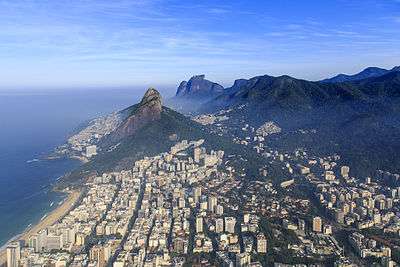
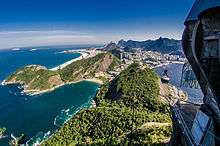
Temperature also varies according to elevation, distance from the coast, and type of vegetation or land use. Winter, cold fronts and dawn/morning sea breezes bring mild temperatures; cold fronts, the Intertropical Convergence Zone (in the form of winds from the Amazon Forest), the strongest sea-borne winds (often from an extratropical cyclone) and summer evapotranspiration bring showers or storms. Thus the monsoon-like climate has dry and mild winters and springs, and very wet and warm summers and autumns. As a result, temperatures over 40 °C (104 °F), that may happen about year-round but are much more common during the summer, often mean the actual temperature feeling is over 50 °C (122 °F), when there is little wind and the relative humidity percentage is high.[41][42][43][44] In such weather, avoiding dehydration (by high consumption of water, and if possibly potassium in people not affected by hyperkalemia, and low consumption of sodium), over-exercising and direct exposure to the sun is recommended, especially for children and elders. Rio de Janeiro is second onlyto Cuiabá as the hottest Brazilian state capital outside Northern and Northeastern Brazil; temperatures below 14 °C (57 °F) occur yearly, while those lower than 11 °C (52 °F) happen less often. The phrase, fazer frio ("making cold", i.e. "the weather is getting cold"), usually refers to temperatures going below 21 °C (70 °F), which is possible year-round and is commonplace in mid-to-late autumn, winter and early spring nights.
There is also a slightly greater seasonal difference in the incidence of solar radiation people receive in Rio de Janeiro (or about anywhere else in the Southern Hemisphere) in comparison to places in the Northern Hemisphere with similar climate and the same exact latitude as the Earth most closely approaches Sol (the local Sun) only 12 days after the Southern Hemisphere's summer solstice. See illustration at the article on the Earth's seasons.
Between 1961 and 1990, at the INMET (Brazilian National Institute of Meteorology) conventional station in the neighborhood of Saúde, the lowest temperature recorded was 10.1 °C (50.2 °F) in October 1977,[45] and the highest temperature recorded was 39 °C (102.2 °F) in December 1963.[46] The highest accumulated rainfall in 24 hours was 167.4 mm (6.6 in) in January 1962.[47] However, the absolute minimum temperature ever recorded at the INMET Jacarepaguá station, 3.8 °C (38.8 °F) in July 1974,[45] while the absolute maximum was 43.2 °C (110 °F) 26 December 2012,[48] in the neighborhood of the Santa Cruz station, while the highest accumulated rainfall in 24 hours, of 186.2 mm (7.3 in) was recorded at the Santa Teresa station in April 1967.[47] The lowest temperature ever registered in the 21st century was 8.1 °C (46.6 °F) in Vila Militar, July 2011.[49]
| Climate data for Rio de Janeiro[note 1] | |||||||||||||
|---|---|---|---|---|---|---|---|---|---|---|---|---|---|
| Month | Jan | Feb | Mar | Apr | May | Jun | Jul | Aug | Sep | Oct | Nov | Dec | Year |
| Record high °C (°F) | 40.9 (105.6) |
41.8 (107.2) |
41 (106) |
39.3 (102.7) |
36.3 (97.3) |
35.9 (96.6) |
34.9 (94.8) |
38.9 (102) |
40.6 (105.1) |
42.8 (109) |
40.5 (104.9) |
42 (108) |
42.8 (109) |
| Average high °C (°F) | 30.2 (86.4) |
30.2 (86.4) |
29.4 (84.9) |
27.8 (82) |
26.4 (79.5) |
25.2 (77.4) |
25 (77) |
25.5 (77.9) |
25.4 (77.7) |
26 (79) |
27.4 (81.3) |
28.6 (83.5) |
27.3 (81.1) |
| Daily mean °C (°F) | 26.3 (79.3) |
26.6 (79.9) |
26 (79) |
24.4 (75.9) |
22.8 (73) |
21.8 (71.2) |
21.3 (70.3) |
21.8 (71.2) |
22.2 (72) |
22.9 (73.2) |
24 (75) |
25.3 (77.5) |
23.8 (74.8) |
| Average low °C (°F) | 23.3 (73.9) |
23.5 (74.3) |
23.3 (73.9) |
21.9 (71.4) |
20.4 (68.7) |
18.7 (65.7) |
18.4 (65.1) |
18.9 (66) |
19.2 (66.6) |
20.2 (68.4) |
21.4 (70.5) |
22.4 (72.3) |
21 (70) |
| Record low °C (°F) | 17.7 (63.9) |
18.9 (66) |
18.6 (65.5) |
16.2 (61.2) |
11.1 (52) |
11.6 (52.9) |
12.2 (54) |
10.6 (51.1) |
10.2 (50.4) |
10.1 (50.2) |
15.1 (59.2) |
17.1 (62.8) |
10.1 (50.2) |
| Average rainfall mm (inches) | 137.1 (5.398) |
130.4 (5.134) |
135.8 (5.346) |
94.9 (3.736) |
69.8 (2.748) |
42.7 (1.681) |
41.9 (1.65) |
44.5 (1.752) |
53.6 (2.11) |
86.5 (3.406) |
97.8 (3.85) |
134.2 (5.283) |
1,069.4 (42.102) |
| Average rainy days (≥ 1 mm) | 11 | 7 | 8 | 9 | 6 | 6 | 4 | 5 | 7 | 9 | 10 | 11 | 93 |
| Average relative humidity (%) | 79 | 79 | 80 | 80 | 80 | 79 | 77 | 77 | 79 | 80 | 79 | 80 | 79.1 |
| Mean monthly sunshine hours | 211.9 | 201.3 | 206.4 | 181 | 186.3 | 175.1 | 188.6 | 184.8 | 146.2 | 152.1 | 168.5 | 179.6 | 2,181.8 |
| Source: Brazilian National Institute of Meteorology (INMET).[37][38][39][40][45][46][50][51][52] | |||||||||||||
Average annual temperature of the sea is 23–24 °C (73–75 °F), from 22 °C (72 °F) in the period July–October to 26 °C (79 °F) in February and March.[53] The dominant ocean current is the warm Brazil Current (as most of elsewhere in the Santos Bight between Santa Catarina and Cabo Frio; the subsurface part of the cold subantarctic Malvinas Current only slightly resurfaces to affect the latter, giving the characteristic semi-arid climate in parts of Arraial do Cabo, the only occurrence of such in the whole state). The wettest and driest months tend to be December and August respectively.
| Jan | Feb | Mar | Apr | May | Jun | Jul | Aug | Sep | Oct | Nov | Dec | Year |
|---|---|---|---|---|---|---|---|---|---|---|---|---|
| 25 °C (77 °F) | 26 °C (79 °F) | 26 °C (79 °F) | 25 °C (77 °F) | 24 °C (75 °F) | 23 °C (73 °F) | 22 °C (72 °F) | 22 °C (72 °F) | 22 °C (72 °F) | 22 °C (72 °F) | 23 °C (73 °F) | 25 °C (77 °F) | 24 °C (75 °F) |
City districts
The city is commonly divided into the historic center (Centro); the tourist-friendly wealthier South Zone (Zona Sul); the residential less wealthy North Zone (Zona Norte); peripheries in the West Zone (Zona Oeste), Santa Cruz and Campo Grande and the wealthy newer Barra da Tijuca district.
Central Zone

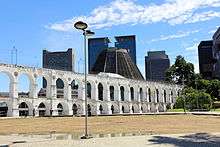
(22°54′19.4112″S 43°10′37.6608″W / 22.905392000°S 43.177128000°W) Centro or Downtown is the historic core of the city, as well as its financial centre. Sites of interest include the Paço Imperial, built during colonial times to serve as a residence for the Portuguese governors of Brazil; many historic churches, such as the Candelária Church (the former cathedral), São Jose, Santa Lucia, Nossa Senhora do Carmo, Santa Rita, São Francisco de Paula, and the monasteries of Santo Antônio and São Bento. The Centro also houses the modern concrete Rio de Janeiro Cathedral. Around the Cinelândia square, there are several landmarks of the Belle Époque of Rio, such as the Municipal Theatre and the National Library building. Among its several museums, the Museu Nacional de Belas Artes (National Museum of Fine Arts) and the Museu Histórico Nacional (National Historical Museum) are the most important. Other important historical attractions in central Rio include its Passeio Público, an 18th-century public garden. Major streets include Avenida Rio Branco and Avenida Vargas, both constructed, in 1906 and 1942 respectively, by destroying large swaths of the colonial city. A number of colonial streets, such as Rua do Ouvidor and Uruguaiana, have long been pedestrian spaces, and the popular Saara shopping district has been pedestrianized more recently. It is also located in the center the traditional neighbourhood called Lapa, important bohemian area frequented by townspeople and tourists.
South Zone
(22°58′27″S 43°11′58″W / 22.974199°S 43.199444°W)
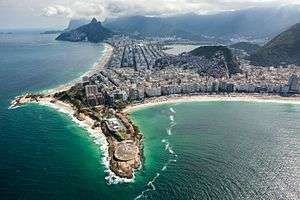
The South Zone of Rio de Janeiro (Zona Sul) is composed of several districts, among which are São Conrado, Leblon, Ipanema, Arpoador, Copacabana, and Leme, which compose Rio's famous Atlantic beach coastline. Other districts in the South Zone are Glória, Catete, Flamengo, Botafogo, and Urca, which border Guanabara Bay and Santa Teresa, Cosme Velho, Laranjeiras, Humaitá, Lagoa, Jardim Botânico, and Gávea.
It is the wealthiest part of the city and the best known overseas; the neighborhoods of Leblon and São Conrado, in particular, have the most expensive real estate in all of South America.
The neighbourhood of Copacabana beach hosts one of the world's most spectacular New Year's Eve parties ("Reveillon"), as more than two million revelers crowd onto the sands to watch the fireworks display. As of 2001, the fireworks have been launched from boats, to improve the safety of the event.[54] To the north of Leme, and at the entrance to Guanabara Bay, is the district of Urca and the Sugarloaf Mountain ('Pão de Açúcar'), whose name describes the famous mountain rising out of the sea. The summit can be reached via a two-stage cable car trip from Praia Vermelha, with the intermediate stop on Morro da Urca. It offers views second only to Corcovado mountain.
Hang gliding is a popular activity on the Pedra Bonita (literally, "Beautiful Rock"). After a short flight, gliders land on the Praia do Pepino (Pepino, or "cucumber", Beach) in São Conrado.
Since 1961, the Tijuca National Park (Parque Nacional da Tijuca), the largest city-surrounded urban forest and the second largest urban forest in the world, has been a National Park. The largest urban forest in the world is the Floresta da Pedra Branca (White Rock Forest), which is also located in the West Zone of Rio de Janeiro.[55] The Pontifical Catholic University of Rio (Pontifícia Universidade Católica do Rio de Janeiro or PUC-Rio), Brazil's top private university, is located at the edge of the forest, in the Gávea district. The 1984 film Blame It on Rio was filmed nearby, with the rental house used by the story's characters sitting at the edge of the forest on a mountain overlooking the famous beaches.
In 2012, CNN elected Ipanema the best city beach in the world.[56]

North Zone



The North Zone (Zona Norte) begins at Grande Tijuca (the middle class residential and commercial bairro of Tijuca and its surrounding neighbourhoods and favelas Slums ), just west of the city center, and sprawls for miles inland until Baixada Fluminense and the city's Northwest.
This region is home to the Maracanã stadium (located in Grande Tijuca), once the world's highest capacity football venue, able to hold nearly 199,000 people, as it did the World Cup final of 1950. In modern times its capacity has been reduced to conform with modern safety regulations and the stadium has introduced seating for all fans. Currently undergoing reconstruction, it has now the capacity for 90,000 fans; it will eventually hold around 80,000 people. Maracanã was site for the Opening and Closing Ceremonies and football competition of the 2007 Pan American Games, and hosted the final match of 2014 FIFA World Cup and will also host the Opening and Closing Ceremonies and football matches of the 2016 Summer Olympics.
Besides Maracanã, the North Zone of Rio also holds other tourist and historical attractions, such "Nossa Senhora da Penha de França Church", the Christ the Redeemer (statue) with its stairway built into the rock bed, 'Manguinhos', the home of Instituto Oswaldo Cruz, a centenarian biomedical research institution with a main building fashioned like a Moorish palace, and the beautiful Quinta da Boa Vista, the park where the historic Imperial Palace is located. Nowadays, the palace hosts the National Museum, specialising in Natural History, Archaeology, and Ethnology.
The International Airport of Rio de Janeiro (Galeão – Antônio Carlos Jobim International Airport, named after the famous Brazilian musician Antônio Carlos Jobim), the main campus of the Federal University of Rio de Janeiro at the Fundão Island, and the State University of Rio de Janeiro, in Maracanã, are also located in the Northern part of Rio.
This region is also home to most of the samba schools of Rio de Janeiro such as Mangueira, Salgueiro, Império Serrano, Unidos da Tijuca, among others. Some of the main neighbourhoods of Rio's North Zone are Alto da Boa Vista which shares the Tijuca Rainforest with the South and Southwest Zones; Tijuca, Vila Isabel, Méier, São Cristovão, Madureira, Penha, Manguinhos, Fundão, Olaria among others.
Many of Rio de Janeiro's roughly 1000 Slums, or favelas, are located in the North Zone.[57] The favelas resemble the slums of Paris, New York or other major cities in the 19th and early 20th centuries in the United States and Europe, or of similar neighborhoods in present underdeveloped countries.
West Zone


West Zone of Rio de Janeiro is a complicated place that makes up more than 50% of the city area. The West Side of Rio has many historic sites because of the old "Royal Road of Santa Cruz" that crossed the territory in the regions of Realengo, Bangu, Campo Grande and finishing at the Royal Palace of Santa Cruz in the Santa Cruz region.
The highest peak of the city of Rio de Janeiro is the Pedra Branca Peak (Pico da Pedra Branca) inside the Pedra Branca State Park. It has an altitude of 1024m. The Pedra Branca State Park (Parque Estadual da Pedra Branca)[58] is the biggest urban state park in the world comprising 17 neighborhoods in the west side, being a "giant lung" in the city with trails,[59] waterfalls and historic constructions like an old aqueduct in the Colônia Juliano Moreira[60] in the neighborhood of Taquara and a dam in Camorim. The park has three principal entrances: the main one is in Taquara called Pau da Fome Core, another entrance is the Piraquara Core in Realengo and the last one is the Camorim Core, considered the cultural heritage of the city.
Santa Cruz and Campo Grande Region have exhibited economic growth, mainly in the Campo Grande neighborhood. Industrial enterprises are being built in contemporarily lower and lower middle class residential Santa Cruz, one of the largest and most populous of Rio de Janeiro's neighbourhoods, most notably Companhia Siderúrgica do Atlântico (CSA), a new steel mill with its own private docks on Sepetiba Bay, which is planned to be South America's largest steel works.[61]
A tunnel called Túnel da Grota Funda, opened in 2012, creating a public transit facility between Barra da Tijuca and Santa Cruz, lessening travel time to the region from other areas of Rio de Janeiro.[62]
Barra da Tijuca region

This area is the most recently modernized region of Rio de Janeiro. The region of Barra da Tijuca includes Barra da Tijuca, Recreio dos Bandeirantes, Vargem Grande, Vargem Pequena, Grumari, Itanhangá, Camorim and Joá.
Westwards from the older zones of Rio, Barra da Tijuca is a flat complex of barrier islands of formerly undeveloped coastal land, which constantly experiences new constructions and developments. It remains an area of accelerated growth, attracting some of the richer sectors of the population as well as luxury companies. High rise flats and sprawling shopping centers give the area a far more Modernism feel than the crowded city centre.
The urban planning of the area, completed in the late 1960s, mixes zones of single-family houses with residential skyscrapers. The beaches of Barra da Tijuca are also popular with the city's residents.
One of the most famous hills in the city is the 842-metre-high (2,762-foot) Pedra da Gávea (Crow's nest Rock) bordering the South Zone. On the top of its summit is a huge rock formation (some, such as Erich von Däniken in his 1973 book, In Search of Ancient Gods, claim it to be a sculpture) resembling a sphinx-like, bearded head that is visible for many kilometres around.
The British arrival in Bangu and the first football match in Brazil
On 6 February 1889 the Bangu Textile Factory was founded, with the former name of Industrial Progress Company of Brazil (Companhia Progresso Industrial do Brasil). The factory was officially opened on 8 March 1893, in a very beautiful architectural complex with styles like Italianate, Neo-Gothic and a tower in Mansard Roof style.
After the opening in 1893, crowded trains with multitudes of workers from Great Britain arrived in Bangu to work in the textile factory. Accordingly, the neighborhood started to take shape with the old farms were becoming worker villages with red bricks houses, a beautiful neo-gothic church was created and exists until nowadays as the Saint Sebastian and Saint Cecilia Parish Church, and street cinemas & cultural buildings appeared.
[63] And in May 1894, Thomas Donohoe, a British worker from Busby, Scotland, set sail from Southampton to Rio, leaving behind his wife and two young sons. Arriving in Bangu, the Scot soon settled among the British community in the village. Though happy with his job, and his new friends, he pined for his old hobby, finding Bangu's Sunday pastimes of cycling or music no match for football.
Donohoe was horrified to discover there were no teams in the neighborhood, no equipment to be bought in the shops, and no knowledge of the game whatsoever among the locals. So he wrote to his wife, Elizabeth, asking her to join him, and to bring a football, as well as their children. And shortly after her arrival, in September 1894, the first football match in Brazil took place in the field beside the textile factory. It was a five-a-side match between British workers, and took place six months before Charles Miller's game.
In December 1903, after a trip to his hometown, Thomas Donohoe brought to Bangu two more football balls. On 17 April 1904 in a house of the old Estevão Street, the Bangu Football Club was formerly created with the presence of Mr. Andrew Procter, Mr. Clarence Hibbs, Mr. Frederich Jacques, Mr. John Starck, Mr. José Soares, Mr. Segundo Maffeu, Mr. Thomas Hellowell, Mr. William French, Mr. William Hellowell and Mr. William Procter. In the record the names of Mr. Thomas Donohoe, Mr. José Villas Boas and Mr. James Hartley don’t appear for some unknown reason but their names were included sequentially as vice-president and in the Board Audit Committee of the Club.[64]
The Bangu Textile Factory closed in 2004. The process of bankruptcy started in the 1970s because of the creeping transition to “favelas” from neighborhoods of the South Side to the West Side of Rio, a problem which made the regions of Bangu and Realengo less appealing. In 2007 all the historic sites of the factory became a shopping mall called Bangu Shopping.
In 2015, in the Rio de Janeiro International Short Film Festival, a short film about Bangu and Thomas Donohoe called “Pass to Mr. Danau” (Bola Para Seu Danau, in Portuguese) won the “Curta Rio Award” together with 9 other Shorts about the city.
Demographics
.jpg)

According to the 2010 IBGE Census, there were 5,940,224 people residing in the city of Rio de Janeiro.[65] The census revealed the following numbers: 3,239,888 White people (51.2%), 2,318,675 Pardo (multiracial) people (36.5%), 708,148 Black people (11.5%), 45,913 Asian people (0.7%), 5,981 Amerindian people (0.1%).[66] The population of Rio de Janeiro was 53.2% female and 46.8% male.[66]
In 2010, the city of Rio de Janeiro was the 2nd most populous city in Brazil, after São Paulo.[67]
Different ethnic groups contributed to the formation of the population of Rio de Janeiro. Before European colonization, there were at least seven different indigenous peoples speaking 20 languages in the region. A part of them joined the Portuguese and the other the French. Those who joined the French were then exterminated by the Portuguese, while the other part was assimilated.[68]

Rio de Janeiro is home to the largest Portuguese population outside of Lisbon in Portugal.[70][71] After independence from Portugal, Rio de Janeiro became a destination for hundreds of thousands of immigrants from Portugal, mainly in the early 20th century. The immigrants were mostly poor peasants who subsequently found prosperity in Rio as city workers and small traders.[72] The Portuguese cultural influence is still seen in many parts of the city (and many other parts of the state of Rio de Janeiro), including architecture and language—almost every person native to Brazil with some cultural contact with Rio and its inhabitants knows how to easily differentiate between fluminense and other Brazilian dialects.
People of Portuguese ancestry predominate in most of the state. The Brazilian census of 1920 showed that 39.74% of the Portuguese who lived in Brazil lived in Rio de Janeiro. Including all of the Rio de Janeiro, the proportion raised to 46.30% of the Portuguese who lived in Brazil. The numerical presence of the Portuguese was extremely high, accounting for 72% of the foreigners who lived in the capital. Portuguese born people accounted for 20.36% of the population of Rio, and those with a Portuguese father or a Portuguese mother accounted for 30.84%. In other words, native born Portuguese and their children accounted for 51.20% of the inhabitants of Rio, or a total of 267,664 people in 1890.[73]
| Group | Population | Percentage[74] |
|---|---|---|
| Portuguese immigrants | 106,461 | 20.36% |
| Brazilians with at least one Portuguese parent | 161,203 | 30.84% |
| Portuguese immigrants and their descendants | 267,664 | 51.2% |
The black community was formed with residents whose ancestors had been brought as slaves, mostly from Angola or Mozambique, as well as more people of Angolan, Mozambican and West African descent from other parts of Brazil. The samba (from Bahia with Angolan influence) and the famous local version of the carnival (from Europe) first appeared under the influence of the black community in the city.
Today, nearly half of the city's population is perceptibly by phenotype black or part black,[75] and a wide majority has some recent Subsaharan ancestor—white in Brazil has more to do with European-looking phenotypes rather than ancestry, and two full siblings can be of different "racial" categories,[76] or actually in a skin color and phenotype continuum between pálido (branco) or fair-skinned, branco moreno or swarthy Caucasian, mestiço claro or lighter skinned multiracial, pardo (mixed race) or and negro or black. Race classifications as they are known in the Anglosphere are not followed in Brazilian culture (at least for most of the population), which captures the concept of cor or "color", the continuous range of phenotypes,[77] and as such perceptions that now most Brazilians are "black rather than white" according to the census data are erroneous in a cultural relativistic viewpoint. Pardo, for example, in popular usage includes those who are caboclos (mestizos), mulatos (mulattoes), cafuzos (zambos), juçaras (archaic term for tri-racials) and westernized Amerindians (which are called caboclos as well), being more of a skin color rather than a racial group in particular.
European and Amerindian ancestries also have overwhelming and wide majorities respectively in Rio de Janeiro's population despite any classifications in IBGE's standardized racial groups, thus there were a bi-directional impact of miscegenation (in minor degree, it also happened in other multicultural white-majority regions, at least in some regions of the United States—a hypodescent society where there was the phenomena of passing—as well Argentina, and it is common elsewhere in Latin America) in both white and black populations.
As a result of the influx of immigrants to Brazil from the late 19th to the early 20th century, one may find in Rio de Janeiro and its metropolitan area communities of Levantine Arabs (mostly Christian or Irreligious), Spaniards, Italians, Germans, Japanese,[78] Jews, and people from different parts of Brazil. The main waves of internal migration came from people of African, mixed or older Portuguese (as colony's settlers) descent from Minas Gerais and people of Eastern European, Swiss, Italian, German, Portuguese and older Portuguese-Brazilian heritage from Espírito Santo in the early and mid-20th century, and people with origins in Northeastern Brazil, of diverse origins, in the mid-to-late and late 20th century, as well some in the early 21st century (the latter more directed to peripheries than the city's core in itself).
| Genomic ancestry of non-related individuals in Rio de Janeiro[79] | ||||
|---|---|---|---|---|
| Race or skin color | Number of individuals | Amerindian | African | European |
| White | 107 | 6.7% | 6.9% | 86.4% |
| Pardo (Mixed race) | 119 | 8.3% | 23.6% | 68.1% |
| Black | 109 | 7.3% | 50.9% | 41.8% |
According to an autosomal DNA study from 2009, conducted on a school in the poor periphery of Rio de Janeiro, the "pardos" there were found to be on average about 80% European, and the "whites" (who thought of themselves as "very mixed") were found out to carry very little Amerindian and/or African admixtures.
"The results of the tests of genomic ancestry are quite different from the self made estimates of European ancestry", say the researchers. In general, the test results showed that European ancestry is far more important than the students thought it would be. The "pardos" for example thought of themselves as ⅓ European, ⅓ African and ⅓ Amerindian before the tests, and yet their ancestry on average reached 80% European.[80][81] Other studies showed similar results[79][82]
| Self-reported ancestry of people from Rio de Janeiro, by race or skin color (2000 survey)[77] | |||
|---|---|---|---|
| Ancestry | White | Pardo | Black |
| European only | 48% | 6% | — |
| African only | — | 12% | 25% |
| Amerindian only | — | 2% | — |
| African and European | 23% | 34% | 31% |
| Amerindian and European | 14% | 6% | — |
| African and Amerindian | — | 4% | 9% |
| African, Amerindian and European | 15% | 36% | 35% |
| Total | 100% | 100% | 100% |
Population growth
Rio de Janeiro is the second largest city in Brazil (after São Paulo) and has a rapidly expanding population and rapidly growing area due to rapid urbanization.
- Changing demographics the city of Rio de Janeiro[83]

Religion
The Rio de Janeiro metropolitan area, according to 2009 research from Fundação Getúlio Vargas (known as Novo Mapa das Religiões), ranks first among Brazilian peripheries in the percentage of Catholics (51.09%) living there. Rio de Janeiro city also ranks among fifth Brazilian federal state capital cities in the percentage of its population that is irreligious (13.33%), barely changing since 2000 (while the first-ranked, Boa Vista, has 21.16%).[84][85] It is also the Brazilian capital with the greatest percentage of Spiritists (now about 4–5%), and with substantial numbers in Afro-Brazilian religions and Eastern religions.
| Religion | Percentage | Number |
| Catholic | 51.09% | 3,229,192 |
| Protestant | 23.37% | 1,477,021 |
| Irreligious | 13.59% | 858,704 |
| Spiritist | 5.90% | 372,851 |
| Umbanda and Candomblé | 1.29% | 72,946 |
| Jewish | 0.34% | 21,800 |
| Source: IBGE 2010.[86] | ||
Urban challenges
There are significant disparities between the rich and the poor in Rio de Janeiro, and different socioeconomic groups are largely segregated into different neighborhoods.[87] Although the city clearly ranks among the world's major metropolises, large swaths of the population live in slums known as favelas. In the favelas, 95% of the population are poor, compared to 40% in the general population.[88] There have been a number of government initiatives to counter this problem, from the removal of the population from favelas to housing projects such as Cidade de Deus to the more recent approach of improving conditions in the favelas, bringing them up to par with the rest of the city, as was the focus of the "Favela Bairro" program and deployment of Pacifying Police Units.
At the same time, in 2000, there were several Rio neighborhoods with Human Development Index scores higher than the most developed countries in the world.[89]
- Leblon neighbourhood (HDI: 0.967; at the same level of
 Norway, the world's highest country HDI)
Norway, the world's highest country HDI) - Bangu neighborhood (HDI: 0.794; at the same level of
 Argentina)
Argentina)
The HDI of Brazil overall was 0.755 and Rio State was 0.761. The city scores 0.800.[90][91]
Economy

Rio de Janeiro has the second largest GDP of any city in Brazil, surpassed only by São Paulo. According to the IBGE, it was approximately US$201 billion in 2008, equivalent to 5.1% of the national total. The services sector comprises the largest portion of GDP (65.52%), followed by commerce (23.38%), industrial activities (11.06%) and agriculture (0.04%).[92][93]
Benefiting from the federal capital position it had for a long period (1763–1960), the city became a dynamic administrative, financial, commercial and cultural center. Greater Rio de Janeiro, as perceived by the IBGE, has a GDP of US$187.374.116.000, constituting the second largest hub of national wealth. Per capita GDP is US$11,786.[94] It concentrates 68% of the state's economic strength and 7.91% of all goods and services produced in the country.[95]

Taking into consideration the network of influence exerted by the urban metropolis (which covers 11.3% of the population), this share in GDP rises to 14.4%, according to a study released in October 2008 by the IBGE. For many years brings together the second largest industrial hub of Brazil, with oil refineries, shipbuilding industries, steel, metallurgy, petrochemical, gas, chemical, textile, printing, publishing, pharmaceutical, beverages, cement and furniture. However, the last decades indicated a sharp transformation in its economic profile, which is acquiring more and more shades of a major national hub of services and businesses.[96] The Rio de Janeiro Stock Exchange (BVRJ), which currently trades only government securities, was the first stock exchange founded in Brazil in 1845 and located in the central region.
Rio de Janeiro became an attractive place for companies to locate when it was the capital of Brazil, as important sectors of society and of the government were present in the city. The city was chosen as headquarters for state-owned companies such as Petrobras, Eletrobras, Caixa Econômica Federal and Vale (which was privatized in the 1990s). After the transfer of the capital to Brasília, in 1960, it kept attracting more companies,[97] especially after the discovery of oil in the Campos Basin, which produces most of the total oil production of Brazil. This made many oil and gas companies to be based in Rio de Janeiro, such as the Brazilian branches of Shell, EBX and Esso. The headquarters of BNDES, an important state institution, is also in Rio de Janeiro. The city is also the headquarters of large telecom companies, such as Intelig, Oi and Embratel.
Rio ranks second nationally in industrial production[98] and second financial and service center, trailing only São Paulo. The city's industries produce processed foods, chemicals, petroleum products, pharmaceuticals, metal products, ships, textiles, clothing, and furniture. The service sector dominates the economy, however, and includes banking and the second most active stock market in Brazil, the Bolsa da Valores do Brasil. Tourism and entertainment are other key aspects of the city's economic life and the city is the nation's top tourist attraction for both Brazilians and foreigners.[99]
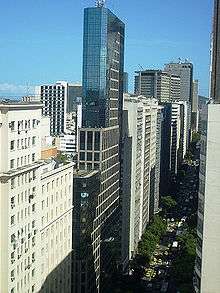
Because it was once the national capital, Rio de Janeiro was chosen as the site for the headquarters of many private, national, multinational, and state corporations, even when their factories were located in other cities or states. Despite the transfer of the capital to Brasília, many of these headquarters remained within the Rio metropolitan area, including those of Petrobrás, the state oil company, and the National Economic and Social Development Bank, a federal investment bank.
A newer electronics and computer sector has been added to the older industries of metallurgy, engineering, and printing and publishing. Other manufacturing sectors focus on the production of shipyard-related materials, apparel and footwear, textiles, nonmetallic mineral products, food and beverages, chemicals, and pharmaceuticals. Construction, also an important activity, provides a significant source of employment for large numbers of unskilled workers and is buoyed by the number of seasonal residents who build second homes in the Greater Rio de Janeiro area.
To attract industry, the state government has designated certain areas on the outskirts of the city as industrial districts where infrastructure is provided and land sales are made under special conditions. Oil and natural gas from fields off the northern coast of Rio de Janeiro state are a major asset used for developing manufacturing activities in Rio's metropolitan area, enabling it to compete with other major cities for new investment in industry.[100]
As with manufacturing, Rio is an important financial centre, second only to São Paulo in volume of business in financial markets and in banking. Its securities market, although declining in significance relative to São Paulo, is still of major importance. Owing to the proximity of Rio's port facilities, many of Brazil's export-import companies are headquartered in the city. In Greater Rio, which has one of the highest per capita incomes in Brazil, retail trade is substantial. Many of the most important retail stores are located in the Centre, but others are scattered throughout the commercial areas of the other districts, where shopping centres, supermarkets, and other retail businesses handle a large volume of consumer trade.[101]

Rio de Janeiro is (as of 2014) the second largest exporting municipality in Brazil. Annually, Rio exported a total of $7.49B (USD) worth of goods.[102] The top three goods exported by the municipality were crude petroleum (40%), semi finished iron product (16%), and semi finished steel products (11%).[103] Material categories of mineral products (42%) and metals (29%) make up 71% of all exports from Rio.[104]
Major Brazilian entertainment and media organizations are based in Rio de Janeiro like Organizações Globo and also some of Brazil's major newspapers: Jornal do Brasil, O Dia, and Business Rio. Major international pharmaceutical companies have their Brazilian headquarters in Rio such as: Merck, Roche, Arrow, Darrow, Baxter, Mayne, and Mappel.
Compared to other cities, Rio de Janeiro's economy is the 2nd largest in Brazil, behind São Paulo, and the 30th largest in the world with a GDP of R$ 201,9 billion in 2010. The per capita income for the city was R$22,903 in 2007 (around US$14,630).[105] According to Mercer's city rankings of cost of living for expatriate employees, Rio de Janeiro ranks 12th among the most expensive cities in the world in 2011, up from the 29th position in 2010, just behind São Paulo (ranked 10th), and ahead of London, Paris, Milan, and New York City.[106][107] Rio also has the most expensive hotel rates in Brazil, and the daily rate of its five star hotels are the second most expensive in the world after only NYC.[108]

Education
The Portuguese language is the official and national language, and thus the primary language taught in schools. English and Spanish are also part of the official high school curriculum. There are also international schools, such as the American School of Rio de Janeiro, Our Lady of Mercy School, the Corcovado German School, the Lycée Français and the British School of Rio de Janeiro.
Educational institutions
The city has several universities and research institutes. The Ministry of Education has certified approximately 99 upper-learning institutions in Rio.[109] The most prestigious university is the Federal University of Rio de Janeiro, the fifth best in Latin America, and the second best in Brazil, second only to the University of São Paulo, the best in Latin America, according to the QS World University Rankings.[110][111]
Some notable higher education institutions are:
- Federal University of Rio de Janeiro (UFRJ);
- Federal University of the Rio de Janeiro state (UNIRIO);
- Rio de Janeiro State University (UERJ);
- Federal Rural University of Rio de Janeiro (UFRRJ, often nicknamed Rural);
- Fluminense Federal University (UFF);
- Pontifical Catholic University of Rio de Janeiro (PUC-Rio);
- Getúlio Vargas Foundation (FGV);
- Military Institute of Engineering (IME);
- Superior Institute of Technology in Computer Science of Rio de Janeiro (IST-Rio);
- College of Publicity and Marketing (ESPM);
- National Institute of Pure and Applied Mathematics (IMPA);
- Federal Center of Technological Education Celso Suckow da Fonseca (CEFET/RJ).
There are more than 137 upper-learning institutions in whole Rio de Janeiro state.[112]

Educational system
Primary schools are largely under municipal administration, while the state plays a more significant role in the extensive network of secondary schools. There are also a small number of schools under federal administration, as is the case of Pedro II School, Colégio de Aplicação da UFRJ and the Centro Federal de Educação Tecnológica of Rio de Janeiro (CEFET-RJ). In addition, Rio has an ample offering of private schools that provide education at all levels. Rio is home to many colleges and universities. The literacy rate for cariocas aged 10 and older is nearly 95 percent, well above the national average.[113]
The Rio de Janeiro State University (public), Federal University of Rio de Janeiro (public), Brazilian Institute of Capital Markets (private) and Pontifical Catholic University of Rio de Janeiro (private) are among the country's top institutions of higher education. Other institutes of higher learning include the Colégio Regina Coeli in Usina, notable for having its own 3 ft (914 mm) narrow gauge[114] funicular railway on its grounds.[115]
In Rio, there were 1,033 primary schools with 25,594 teachers and 667,788 students in 1995. There are 370 secondary schools with 9,699 teachers and 227,892 students. There are 53 University-preparatory schools with 14,864 teachers and 154,447 students. The city has six major universities and 47 private schools of higher learning.[116]
Culture and contemporary life
Rio de Janeiro is a main cultural hub in Brazil. Its architecture embraces churches and buildings dating from the 16th to the 19th centuries, blending with the world-renowned designs of the 20th century. Rio was home to the Portuguese Imperial family and capital of the country for many years, and was influenced by Portuguese, English, and French architecture.[117]
Rio de Janeiro has inherited a strong cultural role from the past. In the late 19th century, there were sessions held of the first Brazilian film and since then, several production cycles have spread out, eventually placing Rio at the forefront of experimental and national cinema. The Rio de Janeiro International Film Festival[118] has been held annually since 1999.[119] Rio currently brings together the main production centers of Brazilian television.[120] Major international films set in Rio de Janeiro include Blame it on Rio; the James Bond film Moonraker; the Oscar award-winning, critically acclaimed Central Station by Walter Salles, who is also one of Brazil's best-known directors; and the Oscar award-winning historical drama, Black Orpheus, which depicted the early days of Carnaval in Rio de Janeiro. Internationally famous, Brazilian-made movies illustrating a darker side of Rio de Janeiro include Elite Squad and City of God.
Rio has many important cultural landmarks, such as the Biblioteca Nacional (National Library), one of the largest libraries in the world with collections totalling more than 9 million items; the Theatro Municipal; the National Museum of Fine Arts; the Carmen Miranda Museum; the Rio de Janeiro Botanical Garden; the Parque Lage; the Quinta da Boa Vista; the Imperial Square; the Brazilian Academy of Letters; the Museu de Arte Moderna do Rio de Janeiro; and the Natural History Museum.
Tourism and recreation

Rio de Janeiro is Brazil's primary tourist attraction and resort. It receives the most visitors per year of any city in South America with 2.82 million international tourists a year.[121] The city sports world-class hotels, approximately 80 kilometres of beaches and the famous Corcovado and Sugarloaf mountains. While the city has in past had a thriving tourism sector, the industry entered a decline in the last quarter of the 20th century. Annual international airport arrivals dropped from 621,000 to 378,000 and average hotel occupancy dropped to 50% between 1985 and 1993.[122]
The fact that Brasília replaced Rio de Janeiro as the Brazilian capital in 1960 and that São Paulo replaced Rio as the country's commercial, financial and cultural main center during the mid-20th century, has also been cited as a leading cause of the decline. Rio de Janeiro's government has since undertaken to modernise the city's economy, reduce its chronic social inequalities, and improve its commercial standing as part of an initiative for the regeneration of the tourism industry.[123]
The city is an important global LGBT destination, 1 million LGBT tourists visit the city of Rio de Janeiro each year.[124] The Rua Farme de Amoedo is located in Ipanema, a famous neighborhood in the South Zone of Rio de Janeiro. The street and the nearby beach, famous tourist spots, are remarkable for their popularity in the LGBT community. Rio de Janeiro is the most awarded destination by World Travel Awards in the South American category of "best destination".[125]
Literature
After Brazilian independence from Portugal in 1822, Rio de Janeiro quickly developed a European-style bourgeois cultural life, including numerous newspapers, in which most 19th-century novels were initially published in serial. Joaquim Manuel de Macedo's A Moreninha (1884) was perhaps the first successful novel in Brazil and inaugurates a recurrent 19th-century theme: a romantic relationship between idealistic young people in spite of cruelties of social fortune. Rio in recent year has had a scheme where adults aged 18 to 25 where made to have literacy tests and education.
The first notable work of realism focusing on the urban lower-middle class is Manuel Antônio de Almeida's Memórias de um sargento de milícias (1854), which presents a series of picaresque but touching scenes, and evokes the transformation of a town into a city with suggestive nostalgia. Romantic and realist modes both flourished through the late 19th century and often overlapped within works.[126] The most famous author of Rio de Janeiro, however, was Machado de Assis, that is also widely regarded as the greatest writer of Brazilian literature[127] and considered the introducer of Realism in Brazil, with the publication of The Posthumous Memoirs of Bras Cubas (1881);[128] he had commented and criticized the political and social events of the city and country such as the abolition of slavery in 1888 and the transition from Empire to Republic with his numerous chronicles published in newspapers of the time.[129] Much of his short stories and novels, like Quincas Borba (1891) and Dom Casmurro (1899), are placed in Rio.
Libraries

The Biblioteca Nacional (National Library of Brazil) ranks as one of the largest libraries in the world. It is also the largest library in all of Latin America.[130] Located in Cinelândia, the National Library was originally created by the King of Portugal, in 1810. As with many of Rio de Janeiro's cultural monuments, the library was originally off-limits to the general public. The most valuable collections in the library include: 4,300 items donated by Barbosa Machado including a precious collection of rare brochures detailing the History of Portugal and Brazil; 2,365 items from the 17th and 18th centuries that were previously owned by Antônio de Araújo de Azevedo, the "Count of Barca", including the 125 volume set of prints "Le Grand Théâtre de l'Univers;" a collection of documents regarding the Jesuítica Province of Paraguay and the "Region of Prata;" and the Teresa Cristina Maria Collection, donated by Emperor Pedro II. The collection contains 48,236 items. Individual items of special interest include a rare first edition of Os Lusíadas by Luis de Camões, published in 1584; two copies of the Mogúncia Bible; and a first edition of Handel's Messiah.[131]
The Portuguese Royal jolie papillon is located at Rua Luís de Camões, in the Centro (Downtown). The institution was founded in 1837 by a group of forty-three Portuguese immigrants, political refugees, to promote culture among the Portuguese community in the then capital of Empire. A history of the Brazilian Academy of Letters is linked to the Royal Cabinet, since the five solemn.[132]
Music
The official song of Rio de Janeiro is "Cidade Maravilhosa", which means "marvelous city". The song is considered the civic anthem of Rio, and is always the favourite song during Rio's Carnival in February. Rio de Janeiro along with São Paulo, is considered the main centre of the urban music movement in Brazil.[133]
Rio was popularised by the hit song "Garota de Ipanema" (The Girl from Ipanema), composed by Antônio Carlos Jobim and Vinicius de Moraes and recorded by Astrud Gilberto and João Gilberto, Frank Sinatra, and Ella Fitzgerald. It is also the main key song of the bossa nova, a musical genre that was born in Rio. A genre unique to Rio and Brazil as a whole is Funk Carioca. While samba music continues to act as the national unifying agent in Rio, Funk Carioca found a strong community following in Brazil. With its genesis in the 1970s as the modern black pop music from the United States, it evolved in the 1990s to describe a variety of electronic music associated with the current US black music scene, including hip hop, modern soul, and house music."[134]
 |
Atraente
Choro "Atraente", composed by Chiquinha Gonzaga, recorded by Pixinguinha (saxophone) and Benedito Lacerda (flute). Choro is a genre of instrumental music that was born in Rio, and it led to a strong tradition that continues today. |
| Problems playing this file? See media help. | |
Brazil's return to democracy in 1985 after over 20 years of military authoritarian rule, and the subsequent end of rampant censorship, allowed for a new freedom of expression which promoted creativity and experimentation in expressive culture.[135] Commercial and cultural imports from Europe and North America have often influenced Brazil's own cultural output. For example, the hip hop that has stemmed from New York is localized into forms of musical production such as Funk Carioca and Brazilian hip hop. Bands from Rio de Janeiro also had influence in the mid-to-late development of the Punk in Brazil, and that of Brazilian thrash metal. Democratic renewal also allowed for the recognition and acceptance of this diversification of Brazilian culture.[136] Rio de Janeiro is also the homeland of the biggest entertainment event in the world, the Rock in Rio Festival, which had editions in 1985, 1991, 2001, 2011 and 2013.
Theatre
Theatro Municipal
Rio Janeiro 's Theatro Municipal is one of the most resplendent buildings in the downtown area of Rio de Janeiro. Home of one of the largest stages in Latin America and one of Brazil's best known venues for opera, ballet, and classical music. The building was inspired by the Paris Opera of Garnier, and built in 1905 by the architect Francisco Pereira Passos. The statues on the top, of two women representing Poetry and Music, are by Rodolfo Bernadelli, and the interior is rich with furnishings and fine paintings. Founded in 1909, the Teatro Municipal was designed after the famed opera house in Paris with close to 1,700 seats. Its interior includes turn of the century stained glass from France, ceilings of rose-colored marble and a 1,000 pound crystal bead chandelier surrounded by a painting of the "Dance of the Hours". The exterior walls of the building are dotted with inscriptions bearing the names of famous Brazilians as well as many other international celebrities.[137]
Cidade da Música
Cidade das Artes (City of Arts) is a cultural complex in Barra da Tijuca in the Southwest Zone of Rio de Janeiro, which was originally planned to open in 2004. Formally known as "Cidade da Música" (City of Music), it has an inauguration anticipated for the beginning of 2013. The project will host the Brazilian Symphony Orchestra becoming a main center for music as will be the largest modern concert hall in South America, with 1,780 seats. The complex spans approximately 90 thousand square metres (1 million square feet) and also features a chamber music hall, three theaters, and 12 rehearsal rooms. From the terrace there is a panoramic view of the region, from Barra's borught. The building was designed by the French architect Christian de Portzamparc and construction was funded by the city of Rio de Janeiro.
Cultural events
New Year's Eve

Every 31 December, 2.5 million people gather at Copacabana Beach to celebrate New Year's in Rio de Janeiro. The crowd, mostly dressed in white, celebrates all night at the hundreds of different shows and events along the beach. It is the second largest celebration only next to the Carnival. People celebrate the New Year by sharing chilled champagne. It is considered good luck to shake the champagne bottle and spray around at midnight. Chilled champagne adds to the spirit of the festivities.[138]
Carnival
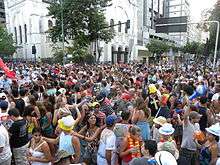
Carnaval, is an annual celebration in the Roman Catholic tradition that allows merry-making and red meat consumption before the more sober 40 days of Lent penance which culminates with Holy or Passion Week and Easter. The tradition of Carnaval parades was probably influenced by the French or German courts and the custom was brought by the Portuguese or Brazilian Imperial families who had Bourbon and Austrian ancestors. Up until the time of the marchinhas, the revelry was more of a high class and Caucasian-led event. The influence of the African-Brazilian drums and music was more noticeable from the first half of the 20th century. Rio de Janeiro has many Carnaval choices, including the famous samba school (Escolas de Samba) parades in the sambadrome exhibition center and the popular blocos de carnaval, street revelry, which parade in almost every corner of the city. The most famous ones are:
- Cordão do Bola Preta: Parades in the centre of the city. It is one of the most traditional carnavals. In 2008, 500,000 people attended in one day.[139] In 2011, a record 2 million people attended the city covering three different metro stations!
- Suvaco do Cristo: Band that parades in the Botanic Garden, directly below the Redeemer statue's arm. The name translates to 'Christ's armpit' in English, and was chosen for that reason.
- Carmelitas: Band that was supposedly created by nuns, but in fact is just a theme chosen by the band. It parades in Santa Teresa, a bairro from where one can see beautiful panoramas.
- Simpatia é Quase Amor: One of the most popular parades in Ipanema. Translates as 'Friendliness is almost love'.
- Banda de Ipanema: The most traditional in Ipanema. It attracts a wide range of revellers, including families and a wide spectrum of the LGBT/Queer population (notably spectacular drag queens).
In 1840, the first Carnaval was celebrated with a masked ball. As years passed, adorned floats and costumed revelers became a tradition among the celebrants. Carnaval is known as a historic root of Brazilian music.[140]

Rock in Rio

"Rock in Rio" is a music festival conceived by entrepreneur Roberto Medina for the first time in 1985, and since its creation, recognized as the largest music festival in the Latin world and the largest in the world, with 1.5 million people attending the first event, 700,000 attending the second and fourth, about 1.2 million attending the third, and about 350,000 people attending each of the 3 Lisbon events. It was originally organized in Rio de Janeiro, from where the name comes from, has become a world level event and, in 2004, had its first edition abroad in Lisbon, Portugal, before Madrid, Spain and Las Vegas, United States. The festival is considered the eighth best in the world by the specialized site Fling Festival.[141]
Sports
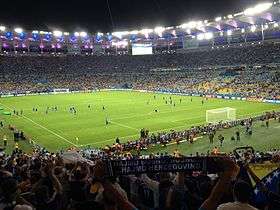

Football
As in the rest of Brazil, football is the most popular sport. The city's major teams are Botafogo, Flamengo, Fluminense and Vasco da Gama. Madureira, Bangu, Portuguesa, America and Bonsucesso are small clubs.
Rio de Janeiro was one of the host cities of the 1950 and 2014 FIFA World Cups, for which on both occasions Brazil was the host nation. In 1950, the Maracanã Stadium hosted 8 matches, including all but one of the host team's matches. The Maracanã was also the location of the infamous tournament-deciding match between Uruguay and Brazil, where Brazil only needed a draw to win the final group stage and the whole tournament. Brazil ended up losing 2–1 in front of a home crowd of more than 199,000. In 2014, the Maracanã hosted seven matches, including the final, where Germany beat Argentina 1–0.
| Club | League | Venue | Established (team) | ||||
|---|---|---|---|---|---|---|---|
| Botafogo FR | Série A | Nilton Santos Stadium
46,931 (43,810 record) |
1894 | ||||
| CR Flamengo | Série A | Maracanã Stadium
78,838 (173,850 record) |
1895 | ||||
| Fluminense FC | Série A | Maracanã Stadium
78,838 (173,850 record) |
1902 | ||||
| CR Vasco | Série B | São Januário Stadium
19,717 (40,209 record) |
1898 | ||||
| Madureira | Série D | Estádio Aniceto Moscoso
5,400 (10,762 record) |
1914 | ||||
| Bangu | Série D | Estádio Moça Bonita
9,564 (17,000 record) |
1904 | ||||
| Portuguesa | Série D | Estádio Luso Brasileiro
15,000 (18,725 record) |
1924 | ||||
| Bonsucesso | Campeonato Carioca | Leônidas da Silva Stadium
13,000 (13,571 record) |
1913 |
-! America |
Campeonato Carioca Série B | Edson Passos
13,544 (9,861 record) |
1904 |
Olympics

.jpg)
On 2 October 2009, the International Olympic Committee selected Rio de Janeiro to host the 2016 Summer Olympics.[142] Rio made their first bid for the 1936 Summer Olympics, but lost to Berlin. They later made bids for the 2004 and 2012 Games, but failed to become a candidate city both times. Those games were awarded to Athens and London respectively.[143] Rio is the first Brazilian and South American city to host the Summer Olympics. Rio de Janeiro also became the first city in the southern hemisphere outside of Australia to host the games – Melbourne in 1956 and Sydney in 2000. In July 2007, Rio successfully organized and hosted the XV Pan American Games.
Rio de Janeiro also hosted the 2011 Military World Games from 15–24 July 2011. The 2011 Military World Games were the largest military sports event ever held in Brazil, with approximately 4,900 athletes from 108 countries competing in 20 sports.[144]
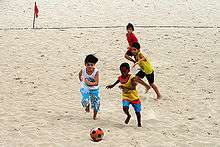
_(14691624052).jpg)
Rio de Janeiro hosted the 2016 Olympics and Paralympics. The Olympic Games were held from 5 to 21 August 2016. The Paralympics were held from 7 to 18 September 2016.
Other sports
The Jacarepaguá circuit in Rio de Janeiro was the site for the Formula One Brazilian Grand Prix from 1978 to 1989. Rio de Janeiro also hosted the MotoGP Brazilian Grand Prix from 1995 to 2004 and the Champ Car event from 1996 to 1999. WCT/WQS surfing championships were contested on the beaches from 1985 to 2001. The Rio Champions Cup Tennis tournament is held in the spring. As part of its preparations to host the 2007 Pan American Games, Rio built a new stadium, Estádio Olímpico João Havelange, to hold 45,000 people. It was named after Brazilian ex-FIFA president João Havelange. The stadium is owned by the city of Rio de Janeiro, but it was rented to Botafogo de Futebol e Regatas for 20 years.[145] Rio de Janeiro has also a multi-purpose arena, the HSBC Arena.
The Brazilian Dance/Sport/Martial art Capoeira is very popular. Other popular sports are basketball, beach football, beach volleyball, Beach American Football, footvolley, surfing, kite surfing, hang gliding, motor racing, Brazilian Jiu-Jitsu, sailing, and competitive rowing. Another sport that is highly popular in beaches of Rio is called "Frescobol" (pronounced: [fɾe̞ɕko̞ˈbɔw]), a type of beach tennis. Rio de Janeiro is also paradise for rock climbers, with hundreds of routes all over the city, ranging from easy boulders to highly technical big wall climbs, all inside the city. The most famous, Rio's granite mountain, the Sugar Loaf (Pão de Açúcar), is an example, with routes from the easy third grade (American 5.4, French 3) to the extremely difficult ninth grade (5.13/8b), up to 280 metres (919 feet).
Horse racing events are held Thursday nights and weekend afternoons at the Jockey Club. An impressive place with excellent grass and dirt tracks, it runs the best horses in the nation. Hang gliding in Rio de Janeiro started in the mid-1970s and quickly proved to be well-suited for this town, because of its geography: steep mountains encounter the Atlantic Ocean, which provide excellent take-off locations and great landing zones on the beach.
One of the most popular sea sports in the city is yachting. The main yacht clubs are in Botafogo area that extends halfway between Copacabana and the center of town. Though the most exclusive and interesting is probably the Rio Yacht club, where high society makes it a point to congregate. Most yacht clubs are open to members only and gate crashing is not easy. Copacabana is also a great place to do surfing as well as "Arpoador of Ipanema" beach and "Praia dos Bandeirantes". The sea at these beaches is rough and dangerous, the best surfers from Brazil and other sites of the world come to these beaches to prove themselves.[146]
Transportation
Airports and ports
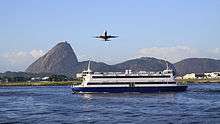
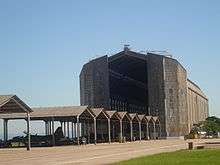
The City of Rio de Janeiro is served by the following airports for use:
- Galeão-Antônio Carlos Jobim International Airport: used for all international and most of the domestic flights. Since August 2004, with the transfer of many flights from Santos-Dumont Airport, Rio de Janeiro International Airport has returned to being the main doorway to the city. Besides linking Rio to the rest of Brazil with domestic flights, Galeão has connections to 19 countries. It has a capacity to handle up to 15 million users a year in two passenger terminals. It is located 20 km (12 mi) from downtown Rio. The airport complex also has Brazil's longest runway at 4,000 m (13,123.36 ft), and one of South America's largest cargo logistics terminals.[147]
- Santos Dumont Airport: used mainly by the services to São Paulo, some short- and medium-haul domestic flights, and general aviation. Located on Guanabara Bay just a few blocks from the heart of downtown Rio, during the 1990s Santos-Dumont began to outgrow its capacity, besides diverging from its specialization on short-hop flights, offering routes to other destinations in Brazil. For this reason, in late 2004 Santos-Dumont returned to its original condition of operating only shuttle flights to and from Congonhas Airport in São Paulo, along with regional aviation. The passenger terminal is presently undergoing extensive renovation and expansion to offer more convenience and comfort to users of the Rio–São Paulo shuttle service.[148]
- Jacarepaguá-Roberto Marinho Airport: used by general aviation and home to the Aeroclube do Brasil (Brasil Flying club). The airport is located in the district of Baixada de Jacarepaguá, within the municipality of Rio de Janeiro approximately 30 km (19 mi) from the city center.[149]
Military airports include:
- Galeão Air Force Base: A Brazilian Air Force airbase, sharing some facilities with Galeão - Antônio Carlos Jobim International Airport;
- Santa Cruz Air Force Base: A Brazilian Air Force airbase. Formerly called Bartolomeu de Gusmão Airport, it was built by the Luftschiffbau Zeppelin. Today it is one of the most important Air Force Bases in Brazil;
- Afonsos Air Force Base: One of the historical Brazilian Air Force airbases. It is also the location of the University of the Air Force (Universidade da Força Aérea),[150] the Museu Aeroespacial,[151] and where air shows take place.
The Port of Rio de Janeiro is Brazil's third busiest port in terms of cargo volume, and it is the center for cruise vessels. Located on the west coast of the Guanabara Bay, it serves the States of Rio de Janeiro, São Paulo, Minas Gerais, and Espírito Santo. The port is managed by Companhia Docas de Rio de Janeiro. The Port of Rio de Janeiro covers territory from the Mauá Pier in the east to the Wharf of the Cashew in the north. The Port of Rio de Janeiro contains almost seven thousand metres (23 thousand feet) of continuous wharf and an 883-metre (2,897-foot) pier. The Companhia Docas de Rio de Janeiro administers directly the Wharf of the Gamboa general cargo terminal; the wheat terminal with two warehouses capable of moving 300 tons of grains; General Load Terminal 2 with warehouses covering over 20 thousand square metres (215 thousand square feet); and the Wharves of Are Cristovao with terminals for wheat and liquid bulk.[152]
At the Wharf of Gamboa, leaseholders operate terminals for sugar, paper, iron and steel products. Leaseholders at the Wharf of the Cashew operate terminals for roll-on/roll-off cargoes, containers, and liquid bulk. In 2004, the Port of Rio de Janeiro handled over seven million tons of cargo on almost 1700 vessels. In 2004, the Port of Rio de Janeiro handled over two million tons of containerized cargo in almost 171 thousand TEUs. The port handled 852 thousand tons of wheat, more than 1.8 million tons of iron and steel, over a million tons of liquid bulk cargo, almost 830 thousand tons of dry bulk, over five thousand tons of paper goods, and over 78 thousand vehicles. In 2003, over 91 thousand passengers moved through the Port of Rio Janeiro on 83 cruise vessels.[153]
Public transportation
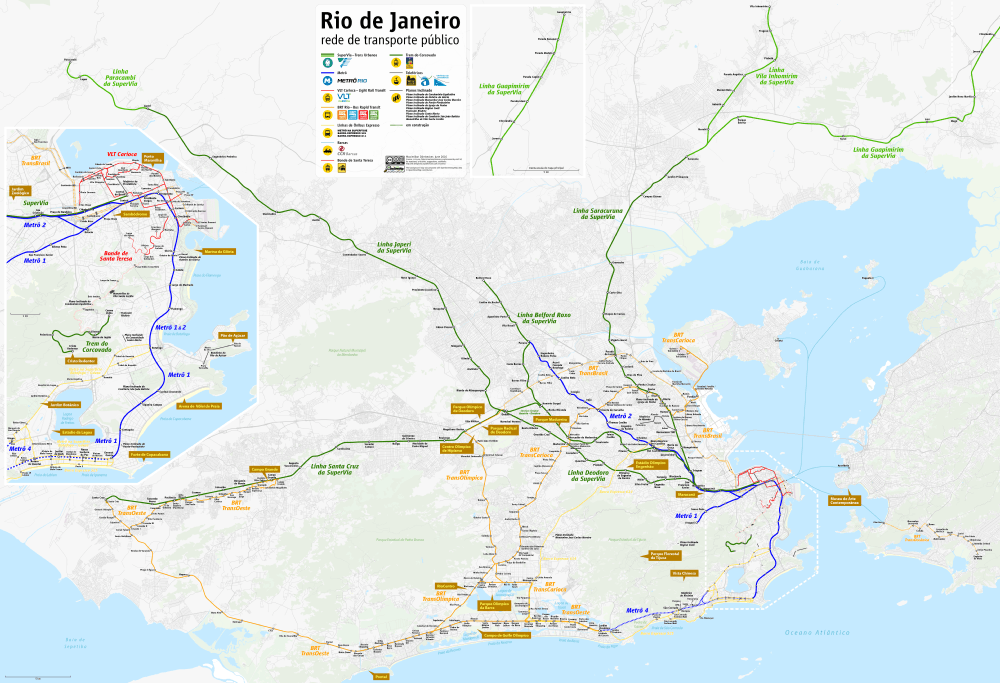
In Rio de Janeiro, buses are the main form of public transportation. There are nearly 440 municipal bus lines serving over four million passengers every day, in addition to intercity lines. Although cheap and frequent, Rio's transportation policy has been moving towards trains and subway in order to reduce surface congestion and increase carrier capacity. Rio's public transportation service has been a target of many critics and the motive of the 2013's protests and manifestations that started in São Paulo and spread through the entire country. According to the people, the raise in the bus and subway fares are invalid, seeing that the amount charged is too high for the low quality of the services.
Subway and urban trains

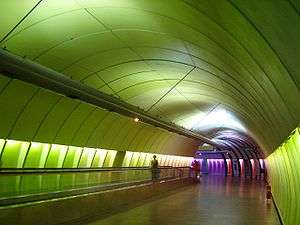
Rio de Janeiro has two subway lines (Metrô Rio) with 42 kilometres (26 mi) and 32 stations plus several commuter rail lines. Future plans include building a third subway line to Niterói and São Gonçalo, including an underwater tunnel beneath Guanabara Bay to supplement the ferry service currently there.[154] The Metro is Rio's safest and cleanest form of public transport.[155]
The two lines serve the city seven days a week. The first line runs from General Osório in Ipanema to Uruguai Station in Tijuca. The second line runs from Botafogo, sharing ten stations with the first line, terminating at Pavuna in northern Rio. The Metro runs services from 05:00 am to 12:00 midnight, Monday to Saturday, and from 07:00 am to 11:00 pm Sundays and public holidays. People can buy tickets for the Metro at train stations and can either buy single tickets or rechargeable cards. People can also buy tickets for the Metro at buses that make connect places far from the Metro. Integration with buses are possible in several forms, an integrated Metro and bus ticket for a single journey is available for some lines paying an additional fee and is known as an Integração Expressa (Express Integration) and Expresso Barra, the other possibility is taking the Metro na Superfície (Surface Metro) with no additional fee.[156][157]
SuperVia connects the city of Rio with other locations in Greater Rio de Janeiro with surface trains.[158]
Bus
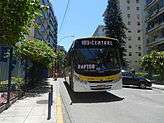

City buses cost about R$3.40 to ride. They come in both non-air conditioned (R$3.40)[159] and air conditioned versions (R$3–R$5.40).[160] The system may be relatively safe by day but less so at night.[161] Integration of bus lines has been recently implemented, allowing users to take two non-air conditioned bus rides in two hours paying just one ticket. It is necessary to have a registered electronic card (the "Bilhete Único Carioca (BUC)") in order to benefit of this system.
Another type of local bus is called the "Frescão" (air-conditioned). These buses run several routes, the main being from Centro through Botafogo, Copacabana and Ipanema to Leblon (and vice versa), and from the International Airport to Barra, through the beach road. They are air conditioned—about 22 °C (72 °F)—more upscale/comfortable and cost between R$6.00–R$12.00.[162] However, it is only available during weekdays. The buses also run more frequently during the rush hours in the morning and evening. Going in the direction of Centro (city center), the bus can be flagged down on the beach road (buses with plaques showing "Castelo").
Ferry
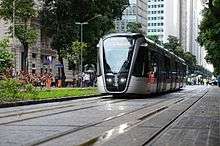
The most geographically close sister city to Rio that is on the other side of Guanabara Bay is Niterói. Many people who live in Niterói, as well its neighbouring municipalities São Gonçalo and Maricá, commute to Rio de Janeiro to study and work. There are several ferry services that operate between the Rio Centro (Praça XV) and Niterói (Centro and Charitas). There is a traditional boat as well as several "fast cat" hydrofoil boats. One of the city neighborhoods is Paquetá Island, which can only be accessed by ferryboats or hydrofoil boats. The ferryboat to Paquetá leaves every hour, from early in the morning until around midnight. There is also a ferry to Cocotá.
Tram and light rail
Rio de Janeiro has the oldest operating electric tramway in Brazil and South America,[163] now mainly used by tourists and less by daily commuters. Santa Teresa Tram or bondinho, has been preserved both as a piece of history and as a quick, fun, cheap way of getting to one of the most quirky parts of the city. The tram station is near Cinelândia and the Municipal Theatre. Trams leave every half an hour between 6:00 am and 11:00 pm. A ticket is just R$0.60 (US$0.35), one way or return, and people pay as they pass through the barrier to the right of the entrance. The Santa Teresa Tram (known locally as the "bonde") in the Brazilian city of Rio de Janeiro commenced electric operation in 1891, replacing horse-drawn trams and expanding the horse-drawn route. At this time the gauge was altered to 1,100 mm (43.31 in), which remains the case today. The tram cars which are currently in operation are Brazilian-built, are of the cross-bench open sided design, and are fitted with trolley poles.[164]
After a derail occurred on 28 August 2011,[165] which left seven dead, tram service was suspended to improve the system, and would be reopened in 2014, just before the 2014 FIFA World Cup but after postponements it was finally reopened in July 2015. While it is being improved, two lines costing R$0.60 carry passengers from Santa Teresa to Centro: SE014 and SE006.
In order to improve traffic in the central zone, the prefecture started the project "Porto Maravilha" (Marvelous Port), which foresees a modern tramway system. It will have five lines and will connect the central business district to Santos Dumont Airport, the ferry station at XV Square, the Novo Rio terminal bus station at Santo Cristo, and the future high-speed rail Leopoldina station between Rio de Janeiro and São Paulo.[166]
The city will also have the VLT system, a network of light rail that is currently under construction in the city of Rio de Janeiro, aimed at integrating the city center, the Santos Dumont Airport and Rio-Niterói barge to the port region city. It is expected that the system is operational by 2016 at the Olympic Games in Rio de Janeiro, and must withdraw at least 60% of buses and 15% of the cars that are currently circulating in the city center.
Road transport
Driving in Rio de Janeiro, as in most large cities of Brazil, might not be the best choice because of the large car fleet. The city is served by a number of expressways, like Linha Vermelha, Linha Amarela, Avenida Brasil, Avenida das Américas and Avenida Infante Dom Henrique (Aterro do Flamengo); in spite of this, traffic jams are very common.[167] Because of the organization of the 2016 Olympics the city is installing four BRT systems to link Barra da Tijuca with other major neighbourhoods: TransOlimpica (between Barra and Deodoro); TransBrasil (over the Avenida Brasil expressway); TransCarioca (between Barra and the Galeão International Airport); and TransOeste (between Barra and Santa Cruz, over Avenida das Américas).
Highways
In Brazil, most interstate transportation is done by road. A large terminal for long-distance buses is in the Santo Cristo neighborhood of Rio de Janeiro. There are also two port facilities for cargo and passenger ships (Rio de Janeiro and Sepetiba port). Rio has roads to all neighbour States. Some roads (like Via Dutra, to São Paulo, and a stretch of the BR-101 which covers the Rio-Niterói bridge) were chartered to private enterprises. The quality of the highways improved much, but was accompanied by a significant increase of the toll fees. From São Paulo: take the BR-116 (Presidente Dutra Federal Highway) or the BR-101 (Rio-Santos Federal Highway). From Belo Horizonte: BR-040. From Salvador: BR-101 or BR-324/BR-116/BR-393/BR-040.
Bicycles
The city has 160 km (99 mi) of cycle paths that, wherever they exist, are very much preferable to riding in the city's traffic. Most paths run alongside beaches and extend intermittently from the Marina da Glória, Centro, through Flamengo, Copacabana and Ipanema, to Barra da Tijuca and Recreio dos Bandeirantes. six kilometres (3.7 miles) of cycle paths traverse the Tijuca National Park.[168]
The Bike Rio began operations in October 2011. This bicycle sharing system is sponsored by the municipal government of Rio de Janeiro in partnership with Banco Itaú. The bike sharing system has 600 bicycles available at 60 rental stations in 14 neighborhoods throughout the city.[169][170]
Water transport
Communications
The dialing code for the city of Rio de Janeiro (RJ) is 21.[171]
International relations
Twin towns – Sister cities
Rio de Janeiro is twinned with:
-
 Adelaide, Australia[172]
Adelaide, Australia[172] -
 Atlanta, United States[173][174]
Atlanta, United States[173][174] -
 Baku, Azerbaijan[175]
Baku, Azerbaijan[175] -
 Cologne, Germany [176]
Cologne, Germany [176] -
 Guimarães, Portugal[177]
Guimarães, Portugal[177] -
 Istanbul, Turkey[178]
Istanbul, Turkey[178] -
 Jerusalem, Israel[179]
Jerusalem, Israel[179] -
 Kaohsiung, Taiwan[180]
Kaohsiung, Taiwan[180] -
 Kiev, Ukraine [181]
Kiev, Ukraine [181] -
 Liverpool, United Kingdom[182][183]
Liverpool, United Kingdom[182][183] -
 Miami Beach, Florida, United States[174]
Miami Beach, Florida, United States[174] -
 Nairobi, Kenya
Nairobi, Kenya -
 Natal, Brazil [184]
Natal, Brazil [184] -
 Newark, New Jersey, United States[174]
Newark, New Jersey, United States[174] -
 Oklahoma City, United States[174]
Oklahoma City, United States[174] -
 Paola, Italy[185]
Paola, Italy[185] -
 Warsaw, Poland [186]
Warsaw, Poland [186]
Union of Ibero-American Capital Cities
Rio de Janeiro is part of the Union of Ibero-American Capital Cities[187] from 12 October 1982 establishing brotherly relations with the following cities:
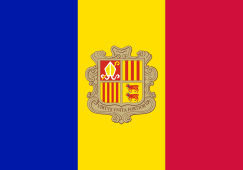 Andorra la Vella, Andorra
Andorra la Vella, Andorra Asunción, Paraguay
Asunción, Paraguay Bogotá, Colombia
Bogotá, Colombia Buenos Aires, Argentina
Buenos Aires, Argentina Caracas, Venezuela
Caracas, Venezuela Guatemala City, Guatemala
Guatemala City, Guatemala Havana, Cuba
Havana, Cuba Quito, Ecuador
Quito, Ecuador La Paz, Bolivia
La Paz, Bolivia Lima, Peru
Lima, Peru Lisbon, Portugal
Lisbon, Portugal Madrid, Spain
Madrid, Spain Managua, Nicaragua[188]
Managua, Nicaragua[188] Mexico City, Mexico
Mexico City, Mexico Montevideo, Uruguay
Montevideo, Uruguay Panama City, Panama
Panama City, Panama Rio de Janeiro, Brazil
Rio de Janeiro, Brazil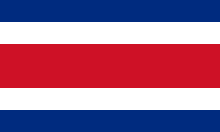 San Jose, Costa Rica
San Jose, Costa Rica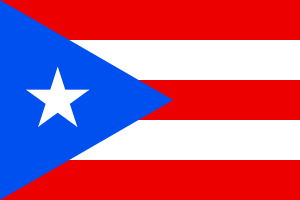 San Juan, Puerto Rico
San Juan, Puerto Rico San Salvador, El Salvador
San Salvador, El Salvador Santiago, Chile
Santiago, Chile Santo Domingo, Dominican Republic
Santo Domingo, Dominican Republic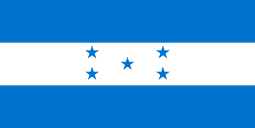 Tegucigalpa, Honduras
Tegucigalpa, Honduras
Partner cities
Rio de Janeiro has the following partner/friendship cities:
See also
- C40 Cities Climate Leadership Group
- Largest cities in the Americas
- List of mayors of Rio de Janeiro
- List of people from Rio de Janeiro
- List of twin towns and sister cities in South America
- List of films set in Rio de Janeiro
Notes
References
- ↑ "Rio de Janeiro Info ('History')". paralumun.com. Retrieved 6 August 2016.
- ↑ "2013 population estimates. Brazilian Institute of Geography and Statistics (IBGE) (1 July 2013)." (PDF). Ibge.gov.br. Retrieved 22 July 2014.
- ↑ It is pronounced [ˈʁi.u d(ʒi) ʒaˈnejɾu] in the variety of Brazilian Portuguese spoken in Rio de Janeiro according to Larousse Concise Dictionary: Portuguese-English, 2008, p. 339. Vowel reduction at /a ~ ɐ/ was added as it is the most often used speech pattern in vernacular, colloquial and educated colloquial modes of speech. [ˈʁi.u dʑi ʑəˈnejɾu] is possibly the way most Brazilians, and particularly most cariocas, would actually pronounce it. The European Portuguese pronunciation is: [ˈʁi.u ðɨ ʒɐˈnɐjɾu].
- ↑ "Rio de Janeiro: travel guide". Retrieved 14 May 2015.
- ↑ "Rio de Janeiro: Carioca Landscapes between the Mountain and the Sea". UNESCO. 1 July 2012. Retrieved 1 July 2012.
- ↑ "Posição ocupada pelos 100 maiores municípios em relação ao Produto Interno Bruto" (PDF). Instituto Brasileiro de Geografia e Estatística (IBGE). 16 December 2008. Retrieved 16 December 2008.
- ↑ "The 150 richest cities in the world by GDP in 2005". City Mayors Statistics. 11 March 2007. Retrieved 8 September 2008.
- ↑ "Assessoria de Comunicação e Imprensa". Universidade Estadual de Campinas (Unicamp). 17 June 2005. Archived from the original on 17 June 2008. Retrieved 8 September 2008.
- ↑ "Rio de Janeiro's Beach Culture" Tayfun King, Fast Track, BBC World News (11 September 2009)
- ↑ "BBC Sport, Rio to stage 2016 Olympic Games". BBC News. 2 October 2009. Retrieved 4 October 2009.
- ↑ Jorge Couto, 1995, A Construção do Brasil, Lisbon: Cosmos.
- ↑ "Encyclopedia of Consumption and Waste: The Social Science of Garbage". Retrieved 2016-09-23.
- ↑ "History of Rio". Paralumun.com. Archived from the original on 27 December 2008. Retrieved 17 April 2010.
- ↑ Alex Robinson; Gardenia Robinson (2014). Rio de Janeiro Footprint Focus Guide: Includes Maracana Stadium, Copacabana, Paraty, Ilha Grande, Ipanema. Footprint Travel Guides. p. 28. ISBN 978-1-909268-88-3.
- ↑ "Real Portuguese Family in Rio". .folha.uol.com.br. 1 January 1970. Retrieved 17 April 2010.
- ↑ "A África civiliza". Multirio.rj.gov.br. Retrieved 17 April 2010.
- ↑ Boone, Christopher G (1995). "Streetcars and Politics in Rio de Janeiro: Private Enterprise versus Municipal Government in Mass Transit Delivery, 1903–1920". Journal of Latin American Studies. 27 (2): 343–365. doi:10.1017/s0022216x00010786.
- ↑ "Drugs and violence in Rio: The bottom line". The Economist. 22 October 2009. Retrieved 21 January 2010.(subscription required)
- ↑ Juscelino Kubitschek and the city of Rio de Janeiro Archived 15 March 2015 at the Wayback Machine.
- ↑ "Where is Rio de Janeiro?". Riobrazilblog.com. 8 March 2011. Retrieved 12 March 2013.
- ↑ Rio de Janeiro — History.com Articles, Video, Pictures and Facts Archived 22 August 2011 at the Wayback Machine.
- ↑ "Area Territorial Official" (in Portuguese). IBGE. Retrieved 18 July 2007.
- ↑ "Estimativas para 1° de Julho de 2006" (in Portuguese). IBGE. Retrieved 18 July 2007.
- ↑ Alvares, Clayton Alcarde; Stape, José Luiz; Sentelhas, Paulo Cesar; de Moraes Gonçalves, José Leonardo; Sparovek, Gerd (2013). "Köppen's climate classification map for Brazil". Meteorologische Zeitschrift. E. Schweizerbart'sche Verlagsbuchhandlung. 22 (6): 711–728. doi:10.1127/0941-2948/2013/0507.
- ↑ "BBC Weather – Rio de Janeiro". BBC Weather. Retrieved 14 May 2015.
- ↑ "Hail falls in Rio de Janeiro's West Zone and Baixada Fluminense" (in Portuguese). Globo News. 12 March 2012. Retrieved 15 March 2012.
- ↑ (Portuguese) https://www.youtube.com/watch?v=r2c-u7vOEdk Little hail shower – Nova Iguaçu, 18 February 2013
- ↑ "As hail falls, Rio enters a warning interval" (in Portuguese). G1. 28 January 2015. Retrieved 2 February 2015.
- ↑ "Brazil drought crisis leads to rationing and tensions". The Guardian. 5 September 2014. Retrieved 2 February 2015.
- ↑ "Brazil's worst drought in history prompts protests and blackouts". The Guardian. 23 January 2015. Retrieved 2 February 2015.
- ↑ "Paraíba do Sul River might not have enough water to rescue São Paulo's Sistema Cantareira" (in Portuguese). G1. 1 February 2015. Retrieved 2 February 2015.
- ↑ "Brazil wastes 37% of potable tap water, a federal report points out". Folha de S. Paulo (in Portuguese). 21 January 2015. Retrieved 2 February 2015.
- ↑ "Tornado is responsible for havoc in Nova Iguaçu, Rio de Janeiro" (in Portuguese). Globo. 20 January 2011. Retrieved 11 April 2012.
- 1 2 "Tornado is responsible for havoc in Nova Iguaçu" (in Portuguese). Gazeta do Povo. 21 January 2011. Retrieved 11 April 2012.
- ↑ Storm with winds above 90 km/h (56 mph) kill one in Rio (Portuguese)
- ↑ "Bangu windstorm, inside the city of Rio, achieved near-cyclone speed" (in Portuguese). G1. 3 January 2015. Retrieved 2 February 2015.
- 1 2 "Temperatura Mínima (°C)" (in Portuguese). Brazilian National Institute of Meteorology. 1961–1990. Archived from the original on 4 May 2014. Retrieved 8 September 2014.
- 1 2 "Temperatura Máxima (°C)" (in Portuguese). Brazilian National Institute of Meteorology. 1961–1990. Archived from the original on 4 May 2014. Retrieved 8 September 2014.
- 1 2 "Temperatura Média Compensada (°C)" (in Portuguese). Brazilian National Institute of Meteorology. 1961–1990. Archived from the original on 4 May 2014. Retrieved 8 September 2014.
- 1 2 "Precipitação Acumulada Mensal e Anual (mm)" (in Portuguese). Brazilian National Institute of Meteorology. 1961–1990. Archived from the original on 4 May 2014. Retrieved 8 September 2014.
- ↑ "Com sensação térmica de 48°C, cariocas se refugiram do calor nas praias" [Feeling like 48°C, cariocas bathe in beaches trying to escape from the heat] (in Portuguese). G1. 23 February 2010. Retrieved 25 June 2013.
- ↑ "Sensação térmica no Rio de Janeiro chega a 50°C nesta terça-feira" [Rio de Janeiro will be feeling like 50°C this Tuesday] (in Portuguese). Yahoo! Notícias. 25 December 2012. Retrieved 25 June 2013.
- ↑ "Sensação térmica no Rio ultrapassa os 50 graus" [Rio de Janeiro's feels like is now greater than 50 celsius] (in Portuguese). Rede TV!. 20 February 2013. Retrieved 25 June 2013.
- ↑ "Sensação térmica no Rio chega aos 51 graus, diz pesquisa do Inpe" [Feels like in Rio gets in 51 celsius mark, according to research] (in Portuguese). O Globo. 3 January 2014. Retrieved 12 January 2014.
- 1 2 3 "Temperatura Mínima Absoluta (ºC)". Brazilian National Institute of Meteorology (Inmet). Archived from the original on 21 June 2014. Retrieved 8 September 2014.
- 1 2 "Temperatura Máxima Absoluta (ºC)". Brazilian National Institute of Meteorology (Inmet). Archived from the original on 21 June 2014. Retrieved 8 September 2014.
- 1 2 "Máximo Absoluto de Precipitação Acumulada (mm)" (in Portuguese). Brazilian National Institute of Meteorology. Archived from the original on 8 May 2014. Retrieved 8 September 2014.
- ↑ "Temperatura desta quarta no Rio é recorde histórico, diz Inmet" (in Portuguese). G1 Rio de Janeiro. 26 December 2012. Retrieved 8 September 2012.
- ↑ "Record lowest temperature since 7.3 °C (45.1 °F) in 2000". Retrieved February 2012. Check date values in:
|access-date=(help) - ↑ "Número de Dias com Precipitação Maior ou Igual a 1 mm (dias)". Brazilian National Institute of Meteorology. Archived from the original on 4 May 2014. Retrieved 8 September 2014.
- ↑ "Insolação Total (horas)". Brazilian National Institute of Meteorology. Archived from the original on 4 May 2014. Retrieved 8 September 2014.
- ↑ "Umidade Relativa do Ar Média Compensada (%)". Brazilian National Institute of Meteorology. Archived from the original on 4 May 2014. Retrieved 8 September 2014.
- 1 2 "Rio de Janeiro Climate Guide". Retrieved 2011. Check date values in:
|access-date=(help) - ↑ Rio Reveillon Archived 13 October 2007 at the Wayback Machine.
- ↑ Engelbrecht Ferreira, Daniel Ernesto (April 2005). "Poluição afeta Pedra Branca" (in Portuguese). O Globo. Retrieved 18 July 2007.
- ↑ Forgan, Duncan (23 May 2012). "World's best city beaches #2". CNNGo.com. Archived from the original on 1 September 2012. Retrieved 31 October 2012.
- ↑ "Reinventing Rio", Alan Riding, September 2010, Smithsonian
- ↑ "Inea – Portal". www.inea.rj.gov.br. Retrieved 25 November 2015.
- ↑ "[PDF] Trail Guide of Pedra Branca State".
- ↑ "Bispo do Rosário Museum, the contemporary museum of Colônia".
- ↑ "SIDERÚRGICA DO ATLÂNTICO VAI GERAR 18 MIL EMPREGOS NA ZONA OESTE". Retrieved 14 May 2015.
- ↑ "Topo do blog Quais serão os novos ares cariocas?". Veja Rio (in Portuguese). 19 November 2011. Archived from the original on 9 July 2014.
- ↑ "Who is the true father of football in Brazil?". BBC Sport. Retrieved 25 November 2015.
- ↑ "Bangu Athletic Club History [Portuguese]".
- ↑ 2010 IGBE Census (Portuguese) Archived 14 May 2012 at the Wayback Machine.
- 1 2 2010 IGBE Census (Portuguese)
- ↑ (Portuguese) The largest Brazilian cities – 2010 IBGE Census
- ↑ "Tem índio no Rio". Paginas.terra.com.br. Archived from the original on 13 August 2007. Retrieved 6 May 2009.
- ↑ Venâncio, R.P., "Presença portuguesa: de colonizadores a imigrantes", in Brasil 500 anos, 2000, Rio de Janeiro, IBGE – Instituto Brasileiro de Geografia e Estatística, from the Brazilian Institute of Geography and Statistics. Archived 28 March 2013 at the Wayback Machine.
- ↑ "Portuguese in Brazil and Rio". Blogluso-carioca.blogspot.com. 29 July 2006. Retrieved 17 April 2010.
- ↑ "Portuguese descent in the city of Rio de janeiro and Brazil". Presidencia.pt. Retrieved 17 April 2010.
- ↑ "Brasil 500 anos". .ibge.gov.br. Archived from the original on 23 May 2008. Retrieved 6 May 2009.
- ↑ Os lusíadas na aventura do Rio moderno, p. 107, at Google Books
- ↑ Rio de Janeiro, uma cidade ... Retrieved 15 September 2011.
- ↑ "Brasil 500 anos". .ibge.gov.br. Archived from the original on 18 May 2008. Retrieved 6 May 2009.
- ↑ Parra, FC; Amado, RC; Lambertucci, JR; Rocha, J; Antunes, CM; Pena, SD (January 2003). "Color and genomic ancestry in Brazilians". Proc. Natl. Acad. Sci. U.S.A. 100 (1): 177–82. Bibcode:2003PNAS..100..177P. doi:10.1073/pnas.0126614100. PMC 140919
 . PMID 12509516.
. PMID 12509516. - 1 2 Edward Eric Telles (2004). "Racial Classification". Race in Another America: the significance of skin color in Brazil. Princeton University Press. pp. 81–84. ISBN 0-691-11866-3.
- ↑ Agencia Brasil (11 March 2011). "Consulado do Japão no Rio disponibiliza telefone para prestar informações sobre o país | Agencia Brasil". Agenciabrasil.ebc.com.br. Retrieved 15 September 2011.
- 1 2 http://laboratoriogene.info/Ciencia_Hoje/Pharmacogenetics2007.pdf
- ↑ "Negros e pardos do Rio têm mais genes europeus do que imaginam, segundo estudo". Meionews.com.br. Retrieved 15 September 2011.
- ↑ (PDF) http://www4.ensp.fiocruz.br/informe/anexos/ric.pdf. Retrieved 23 August 2011. Missing or empty
|title=(help) - ↑ Durso, DF; Bydlowski, SP; Hutz, MH; Suarez-Kurtz, G; Magalhães, TR; Pena, SD (2014). "Association of genetic variants with self-assessed color categories in Brazilians". PLoS ONE. 9 (1): e83926. Bibcode:2014PLoSO...983926D. doi:10.1371/journal.pone.0083926. PMC 3885524
 . PMID 24416183.
. PMID 24416183. - ↑ "Barsa Planeta Ltda". Brasil.planetasaber.com. Retrieved 17 April 2010.
- ↑ Roraima heads in Irreligion percentage ranking, Rio de Janeiro state is in #2 Data from Fundação Getúlio Vargas. (Portuguese)
- ↑ Piauí is the most Roman Catholic state in Brazil despite growth in Evangelicals, Pentecostals and other Protestants Data from FGV. (Portuguese) Archived 8 May 2013 at the Wayback Machine.
- ↑ "Sistema IBGE de Recuperação Automática — SIDRA". Sidra.ibge.gov.br. Retrieved 11 October 2012.
- ↑ Disparities between rich and poor
- ↑ "FGV: desigualdade entre favela e asfalto cai no Rio". Revistaepoca.globo.com. 31 August 2010. Retrieved 16 October 2010.
- ↑ HDI (PDF) (in Portuguese). Rio, Brazil: PNUD. 2000. ISBN 85-240-3919-1. Retrieved 9 January 2008.
- ↑ "IBGE – Cidades – Rio de Janeiro". ibge.gov.br.
- ↑ "IBGE – Cidades – Rio de Janeiro – Rio de Janeiro". ibge.gov.br.
- ↑ "Rio de Janeiro %28city%29". Gold.dreab.com. Archived from the original on 26 April 2012. Retrieved 12 March 2013.
- ↑ "BCG – About BCG – Rio de Janeiro". Retrieved 14 May 2015.
- ↑ Economist (30 August 2011). "Comparing Brazilian states with countries". Magazine. Economist. Retrieved 3 October 2012.
- ↑ "Cidade – Protected Planet". Retrieved 14 May 2015.
- ↑ "Economy Of Rio de Janeiro, need To Know Economy Of Rio de Janeiro, About Economy Of Rio de Janeiro". Retrieved 14 May 2015.
- ↑ "History of economy". Ibge.gov.br. Retrieved 17 April 2010.
- ↑ "IBGE – Economy of Rio de Janeiro". Sidra.ibge.gov.br. Retrieved 17 April 2010.
- ↑ "Tourism in Rio". Portalemfoco.com.br. Archived from the original on 6 July 2011. Retrieved 17 April 2010.
- ↑ "Rio de Janeiro será a capital do petróleo entre os dias 13 e 16 de setembro – Agricultura |RuralBR". Agricultura.ruralbr.com.br. Retrieved 12 March 2013.
- ↑ "Economy of Rio". Britannica.com. Retrieved 17 April 2010.
- ↑ DataViva. "2014 Brazilian Trade by Municipality", DataViva, Retrieved on 17 June 2015.
- ↑ DataViva. "Exports by Product for Rio de Janeiro (2014)", DataViva, Retrieved 17 June 2015.
- ↑ DataViva. "International Trade by Section for Rio de Janeiro (2014)", DataViva, Retrieved 17 June 2015.
- ↑ per capita income (PDF) (in Portuguese). Rio de Janeiro, Brazil: IBGE. 2005. ISBN 85-240-3919-1. Retrieved 21 July 2009.
- ↑ "Worldwide Cost of Living survey 2011 – Top 50 cities: Cost of living ranking". Mercer. 12 July 2011. Archived from the original on 25 July 2011. Retrieved 22 July 2011.
- ↑ "SP é a 10ª cidade mais cara do mundo para estrangeiros; RJ é a 12ª". UOL Noticias (in Portuguese). 12 July 2011. Retrieved 22 July 2011.
- ↑ "Rio de Janeiro lidera lista de hotéis mais caros do País". UOL Noticias (in Portuguese). 23 March 2011. Retrieved 22 July 2011.
- ↑ MEC – Ministério da Educação. "e-MEC". Retrieved 14 May 2015.
- ↑ Pati, Camila. "As 18 melhores universidades do Brasil em 2015 - EXAME.com". abril.com.br.
- ↑ "QS University Rankings: Latin America 2015". topuniversities.com. 28 May 2015.
- ↑ OnLine – Hospedagens e Desenvolvimento de Web Sites. "Faculdades reconhecidas pelo MEC, Vestibular, Apostilas, Universitário, Profissão, Professor". Ser Universitário. Retrieved 14 May 2015.
- ↑ "Education in Rio". Student.britannica.com. Retrieved 17 April 2010.
- ↑ Zeitschrift Blickpunkt Straßenbahn (Tram Focus Magazine) – Trams of the World 2013
- ↑ "Brasilien". Retrieved 14 May 2015.
- ↑ "Educational system in Rio". City-data.com. Retrieved 17 April 2010.
- ↑ "FBN Summit". Retrieved 14 May 2015.
- ↑ festivaldorio.com.br
- ↑ "Rio de Janeiro International Film Festival". Retrieved 14 May 2015.
- ↑ "Coming Soon page". Retrieved 14 May 2015.
- ↑ "Rio de Janeiro is the main tourist destination in the South Hemisphere". 29 January 2010. Retrieved 11 February 2010.
- ↑ Flickr roger4336. "Rio de Janeiro". TouristLink. Retrieved 14 May 2015.
- ↑ Boniface, Brian G.; Cooper, Christopher P. (2005). Worldwide destinations casebook: the geography of travel and tourism. Butterworth-Heinemann. pp. 233–35. ISBN 0-7506-6440-1.
- ↑ Do G1 RJ (24 November 2011). "G1 – Rio recebe quase 1 milhão de turistas homossexuais por ano, diz pesquisa – notícias em Rio de Janeiro". G1.globo.com. Retrieved 31 October 2012.
- ↑ "WORLD TRAVEL AWARDS". 2011. Retrieved 11 February 2010.
- ↑ Piers Armstrong. "Rio's novel history". Cco.cambridge.org. Retrieved 17 April 2010.
- ↑ Candido; Antonio. (1970) Vários escritos. São Paulo: Duas Cidades. p.18.
- ↑ Faraco, Carlos Emílio e Moura, Francisco Mato. Português Projetos. São Paulo: Editora Ática, 2009, p.227.
- ↑ Gledson, John. J. Machado de Assis, ficção e história. Rio de Janeiro: Paz e Terra, 1986, p.13.
- ↑ "National Library of Rio de Janeiro". Rio-de-janeiro.info. Retrieved 17 April 2010.
- ↑ "Official website – National Library of Rio". Bn.br. 25 August 2008. Archived from the original on 28 March 2010. Retrieved 17 April 2010.
- ↑ "Um pedaço de Portugal no Rio de Janeiro – Opinião e Notícia". opiniaoenoticia.com.br. 28 May 2011.
- ↑ Behague, Gerard. "Rap, Reggae, Rock, or Samba: The Local and the Global in Brazilian Popular Music (1985–1995)." Latin American Music Review 27, no. 1 (Spring/Summer 2006): 79–90
- ↑ Sansone, Livio. "The Localization of Global Funk in Bahia and Rio." In Brazilian Popular Music & Globalization, 135–60. London: Routledge, 2002.
- ↑ "Music in the city". Georgemlima.blogspot.com. 24 February 2004. Retrieved 17 April 2010.
- ↑ Behague, Gerard (2006). "Globalization/Modernization: Rap, Reggae, Rock, or Samba: The Local and the Global in Brazilian Popular Music (1985–1995)". Latin American Music Review. 27 (1): 79–90.
- ↑ "Teatro Municipal do Rio". Rio-de-janeiro.info. Retrieved 17 April 2010.
- ↑ "New Year – Rio". Copacabana.info. Archived from the original on 29 December 2010. Retrieved 17 April 2010.
- ↑ "Cordão do Bola Preta in Rio". Carnaval.uol.com.br. Retrieved 17 April 2010.
- ↑ "Brazilian Music: Roots 3". Maria-brazil.org. Retrieved 6 May 2009.
- ↑ "The Top 10 Music Festivals in the World" Check
|url=value (help). festivalfling.com. Retrieved 19 September 2013. - ↑ Michaelis, Vicki (2 October 2009). "Rio de Janeiro to host 2016 Olympic Games". USA Today. Retrieved 2 October 2009.
- ↑ "Rio de Janeiro, Brazil". Bid city profile and Fact sheet. GamesBids.com. Retrieved 3 July 2008.
- ↑ Rio 2011 Military Games Presentation Rio 2011 Official Website. Retrieved on 16 July 2011.
- ↑ "Botafogo vai administrar estádio olímpico do Engenhão". Correio Web. Archived from the original on 17 December 2007. Retrieved 28 August 2007.
- ↑ "Sports in the city of Rio". Studylanguages.org. Retrieved 17 April 2010.
- ↑ "International Airport of Rio de Janeiro". Infraero. Archived from the original on 23 April 2008. Retrieved 17 April 2010.
- ↑ "National Airport of Rio de Janeiro". Infraero. Archived from the original on 21 May 2008. Retrieved 17 April 2010.
- ↑ "Jacarepaguá Airport". Infraero. Archived from the original on 6 July 2009. Retrieved 17 April 2010.
- ↑ University of the Air Force
- ↑ "MUSEU AEROESPACIAL". Retrieved 14 May 2015.
- ↑ "WPS – Port of Rio de Janeiro contact information". Worldportsource.com. Retrieved 31 October 2012.
- ↑ "Port of Rio de Janeiro". Worldportsource.com. Retrieved 17 April 2010.
- ↑ "O DIA Online — Linha 3 do metrô vai receber R$35 milhões da União". odia.terra.com.br. 21 February 2008. Retrieved 6 May 2009.
- ↑ Do G1, no Rio, com informações da TV Globo. "Metro Rio – Transport". G1.globo.com. Retrieved 17 April 2010.
- ↑ "Metro Rio". Metro Rio. Retrieved 17 April 2010.
- ↑ "Metro Rio Integrações". Metro Rio. Archived from the original on 17 December 2007. Retrieved 10 August 2011.
- ↑ "SuperVia". SuperVia. Retrieved 16 October 2010.
- ↑ "Passagem de ônibus sobe de R$ 2,50 para R$ 2,75 no Rio". G1. 2 January 2012. Retrieved 9 May 2012.
- ↑ "Novas tarifas de ônibus com ar condicionado e da integração ônibus-metrô". SMTR – Secretaria Municipal de Transportes. 2 January 2012. Retrieved 9 May 2012.
- ↑ "Bus – Transportation in Rio". Tripadvisor.com. Retrieved 17 April 2010.
- ↑ "Nossas Linhas – Premium". Real Auto Ônibus. Retrieved 9 May 2012.
- ↑ "Bonde de Santa Teresa – a set on Flickr". Flickr.com. Retrieved 12 March 2013.
- ↑ Santa Tereza Tram הכטן7מריכטד7ג
- ↑ G1: Bombeiros confirmam cinco mortos em acidente com bonde no Rio. Retrieved 9 May 2012.
- ↑ Resultados, AM4 – A Internet de. "Porto Maravilha". portomaravilha.com.br.
- ↑ "Driving in Rio de Janeiro". Rioholiday.com. Archived from the original on 24 May 2009. Retrieved 6 May 2009.
- ↑ "Getting around Rio de Janeiro". Worldtravelguide.net. Archived from the original on 27 January 2010. Retrieved 17 April 2010.
- ↑ Louise Peres (28 October 2011). "Prefeitura lança Bike Rio, novo sistema de aluguel de bicicletas da cidade" [City Hall launches Bike Rio, the city's new bike sharing system]. Veja Rio (in Portuguese). Archived from the original on 2 April 2013. Retrieved 11 November 2012.
- ↑ Louise Peres (28 October 2011). "Itaú patrocina programa de aluguel de bicicletas no Rio" [Itau sponsors bike sharing program in Rio]. Exame (in Portuguese). Retrieved 11 November 2012.
- ↑ "DDD Rio de Janeiro (RJ)" (in Portuguese). Codigos DDD. Retrieved 12 August 2016.
- ↑ "Lei Ordinária". Retrieved 14 May 2015.
- ↑ "Atlanta Sister Cities Commission". City of Atlanta. Retrieved 18 February 2013.
- 1 2 3 4 Sister Cities International 2015 Membership Directory, pp. 53–54. Sister Cities International. Accessed 31 August 2015.
- ↑ Баку и Рио-де-Жанейро стали городами-побратимами – 1NEWS.AZ Archived 7 December 2013 at the Wayback Machine.
- ↑ "Cologne International: Rio de Janeiro is Cologne's new twin city" (PDF). Cologne City Business News. Retrieved 28 April 2012.
- ↑ Lei nº 2.643/1998. Câmara Municipal do Rio de Janeiro. Página visitada em 26 de dezembro de 2008.
- ↑ "Sister cities". Radikal.com.tr. Retrieved 17 April 2010.
- ↑ "Lei Ordinária". Retrieved 14 May 2015.
- ↑ "Lei Ordinária". Retrieved 14 May 2015.
- ↑ "Lei Municipal do Rio de Janeiro 4917 de 2008 – Wikisource" (in Portuguese). Pt.wikisource.org. Retrieved 14 June 2010.
- ↑ Waddington, Marc (4 January 2012). "Liverpool's twin cities". liverpoolecho.co.uk.
- ↑ "Twin Cities: Liverpool & Rio de Janeiro — The City Tribune". thecitytribune.net.
- ↑ Leis sancionadas e vetos (21 de janeiro de 2008). Lei n.º 4.752/2008. Câmara Municipal do Rio de Janeiro. Página visitada em 26 de outubro de 2008.
- ↑ "O Globo – Dez cidades-irmãs do Rio". globo.com.
- ↑ "Miasta partnerskie Warszawy". um.warszawa.pl (official Warsaw website). Biuro Promocji Miasta. 4 May 2005. Archived from the original on 11 October 2007. Retrieved 29 August 2008.
- ↑ "Unión de Ciudades Capitales Iberoamericanas: Rio de Janeiro, símbolo de Brasil". Archived from the original on 5 April 2016. Retrieved 5 April 2016.
- ↑ "Hermandad con la ciudad de Rio de Janeiro – Brasil" (in Spanish). Managua.gob.ni. Retrieved 28 March 2015.
- ↑ "Lei Ordinária". Retrieved 14 May 2015.
- ↑ "Lei Ordinária". Retrieved 14 May 2015.
- ↑ "Lei Ordinária". Retrieved 14 May 2015.
- ↑ "Lei Ordinária". Retrieved 14 May 2015.
- ↑ "Villes jumelées avec la Ville de Nice" (in French). Ville de Nice. Archived from the original on 29 October 2012. Retrieved 24 June 2013.
- ↑ Mairie de Paris. "Les pactes d'amitié et de coopération". Retrieved 14 May 2015.
- ↑ "Lei 1383/89 – Lei nº 1383 de 10 de maio de 1989". JusBrasil. Retrieved 14 May 2015.
- ↑ "Lei Ordinária". Retrieved 14 May 2015.
External links
| Wikimedia Commons has media related to: |
| Wikivoyage has a travel guide for Rio de Janeiro. |
- 'let's go back to Rio', RGSSA blog post on Rio in 1904
- Rio de Janeiro Photo Gallery – Year of Brazil at Queens College, CUNY
- Images of Rio—Hundreds of images from the 1920s to the present
- Rio de Janeiro | Places to Go and Tourist Attractions
- AboutBrasil/Rio de Janeiro – The Marvellous City
- TheBrazilGuide/Rio de Janeiro – Things to do
-
 Geographic data related to Rio de Janeiro at OpenStreetMap
Geographic data related to Rio de Janeiro at OpenStreetMap

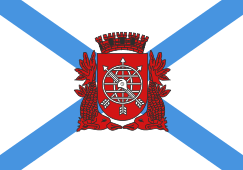

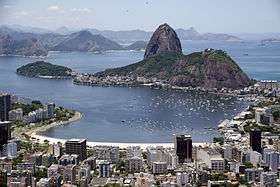
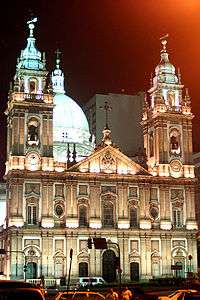
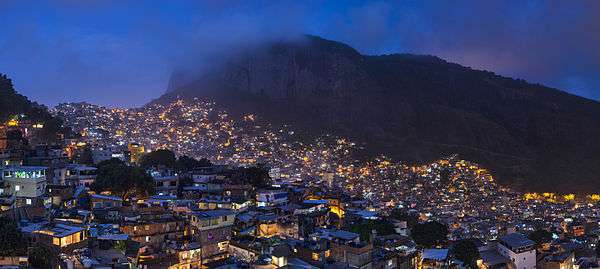


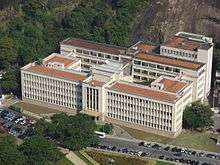
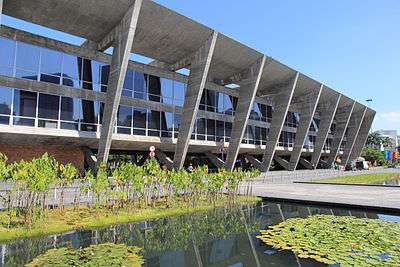







.jpg)

